38 most beautiful places in the Andes Mountains Peru [with map!]
Here are the most beautiful places to visit in the Andes Mountains Peru together with hiking information, difficulty level, things to do, getting there, and more!
The Andes Mountains in Peru are special for several reasons, encompassing a rich tapestry of biodiversity, dramatic landscapes, and profound historical significance.
This mountain range is home to ancient civilizations, including the Incas, whose remarkable engineering and architectural feats, such as Machu Picchu, are nestled within its peaks.
The Andes also boast diverse ecosystems, from the arid Atacama Desert to lush cloud forests and towering snow-capped peaks, providing habitats for unique flora and fauna.
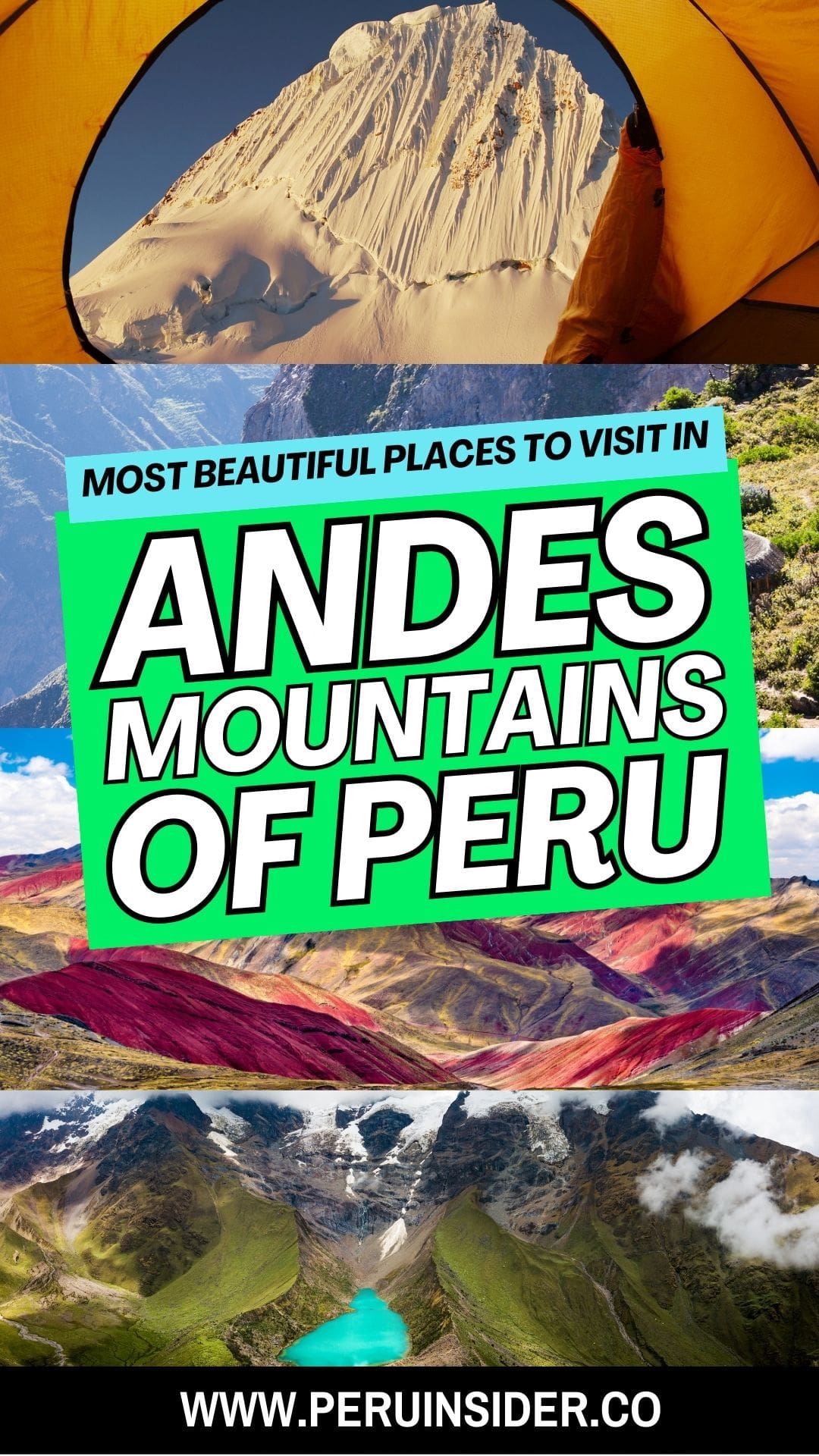
The Andes Mountain range, the longest continental mountain range in the world, extends well beyond Peru, stretching from the southern tip of South America in Chile and Argentina, through Bolivia, Peru, Ecuador, and Colombia, and ending in Venezuela.
In Peru, the Andes traverse the country from north to south, dividing it into three distinct regions: the coastal desert to the west, the Andes themselves, and the Amazon basin to the east. This geographical diversity contributes to Peru’s varied climates and ecosystems.
Visiting the Peruvian Andes requires a good level of physical fitness and preparation due to the high altitudes and the physical demands of trekking or climbing. You should be prepared for altitude sickness, which can affect anyone, regardless of fitness level, above 2,500 meters (8,202 feet).
🦙 Join our 14-day Peru expedition!

Discover Peru from Lima to Cusco on a 14-day expedition with the coolest travelers on the block! Our group trips to Peru are joined by a super fun and dynamic group of travelers of all ages!
Here are the most beautiful places to visit in the Andes Mountains Peru together with hiking information, difficulty level, things to do, getting there, and more!
1. Machu Picchu: the crown jewel of the Andes Mountains Peru
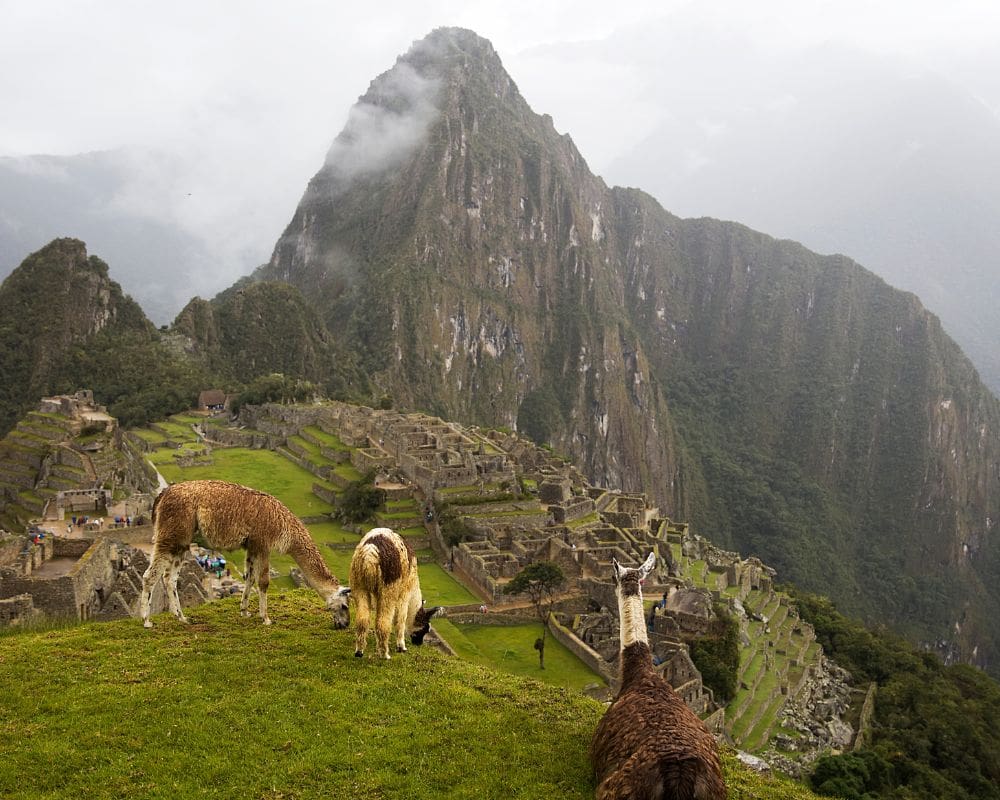
Machu Picchu is undoubtedly the crown jewel of the Andes Mountains Peru, offering visitors a glimpse into the Inca civilization’s architectural prowess and its harmonious relationship with nature.
Machu Picchu is famous for being one of the most significant and well-preserved sites of the Inca Empire. It is recognized as a UNESCO World Heritage Site and one of the New Seven Wonders of the World, attracting millions of tourists annually.
To fully appreciate the beauty and solitude of Machu Picchu, consider entering the site at sunrise by hiking the Inca Trail or taking the first bus up from Aguas Calientes.
2. Colca Canyon

The Colca Canyon in the Andes Mountains Peru is a destination that beckons adventurers and nature lovers alike.
Twice as deep as the Grand Canyon, it offers stunning landscapes, traditional Andean villages, and the chance to see the majestic Andean condors in flight. The area’s natural hot springs and the local culture add to its allure, making it a worthwhile excursion from Arequipa.
Colca Canyon is known for being one of the deepest in the world and a prime location for spotting the Andean condor, a symbol of the Andes. It also boasts a rich history with pre-Incan and Incan sites and terraced agriculture that dates back centuries.
For an unforgettable experience, visit the Cruz del Condor viewpoint early in the morning when the condors are most active and likely to be seen soaring on the thermal currents.
Be sure to acclimatize to the high altitude in Arequipa before attempting any hikes in the canyon.
3. Lake Titicaca
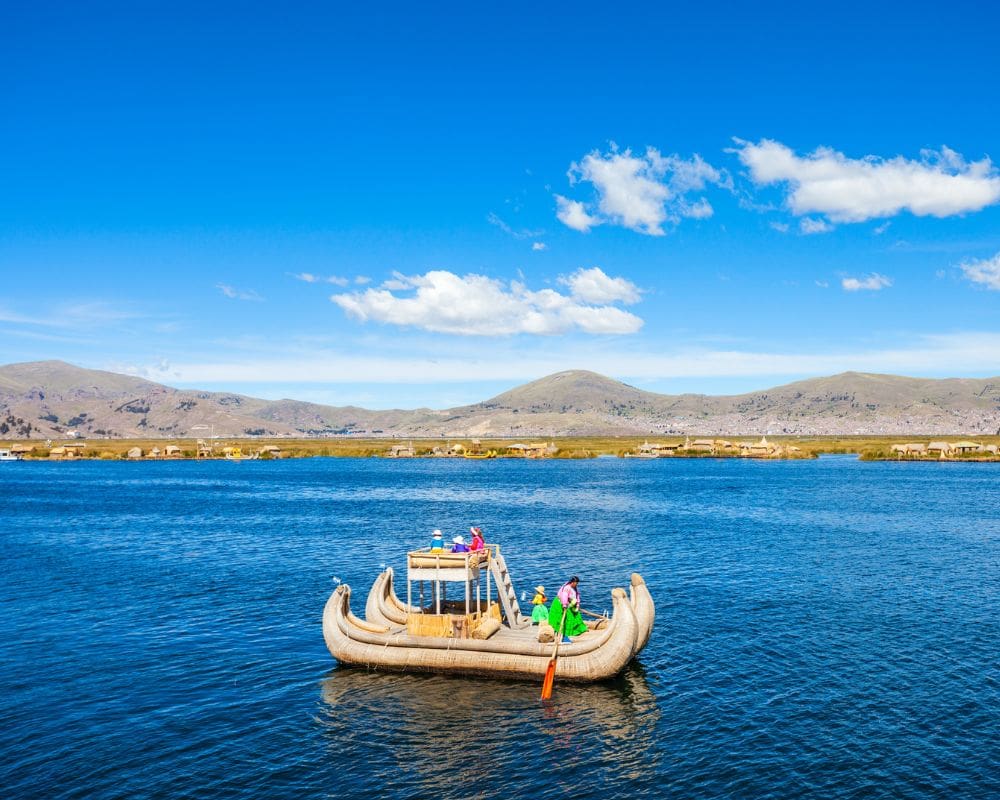
Lake Titicaca, straddling the border between Peru and Bolivia in the Andes Mountains Peru, is famed for its sapphire-blue waters and floating reed islands.
As the highest navigable lake in the world, it offers unique cultural experiences with its indigenous communities, such as the Uros, who live on islands made of totora reeds.
The lake is famous for its floating islands and the traditional way of life of its inhabitants, who maintain customs and crafts passed down through generations. It is also known for its archaeological sites, including the ancient pilgrimage site of Isla del Sol.
Opt for a homestay experience on one of the lake’s islands, such as Amantaní or Taquile, to immerse yourself in the local culture and enjoy homemade Andean meals. This is a unique opportunity to connect with the local communities and learn about their traditions firsthand.
4. Rainbow Mountain
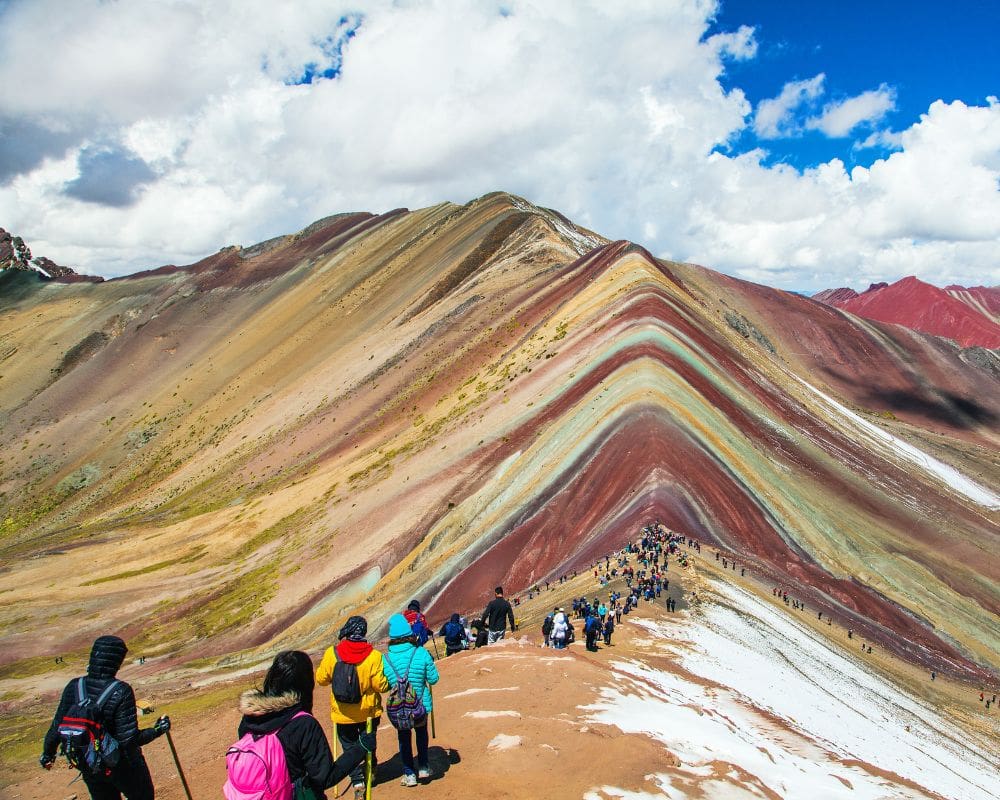
The Rainbow Mountain, or Vinicunca, is a spectacular natural wonder in the Andes Mountains Peru, famous for its strikingly colorful mineral-rich sediments.
This relatively newly discovered attraction draws visitors for its unique geological formations and the opportunity to hike through some of the most untouched landscapes in the region. The challenging trek is rewarded with panoramic views of vibrant hues that seem almost otherworldly.
Rainbow Mountain is famous for its vivid stripes of colors, ranging from turquoise to lavender to maroon, created by weathering and mineral deposits over time. It has quickly become one of the most photographed natural phenomena in Peru.
Start your hike early to avoid the crowds and enjoy clearer views before the afternoon clouds roll in. Since the altitude can be challenging, it’s advisable to spend a few days acclimatizing in Cusco and bring plenty of water and snacks for the journey.
5. Choquequirao
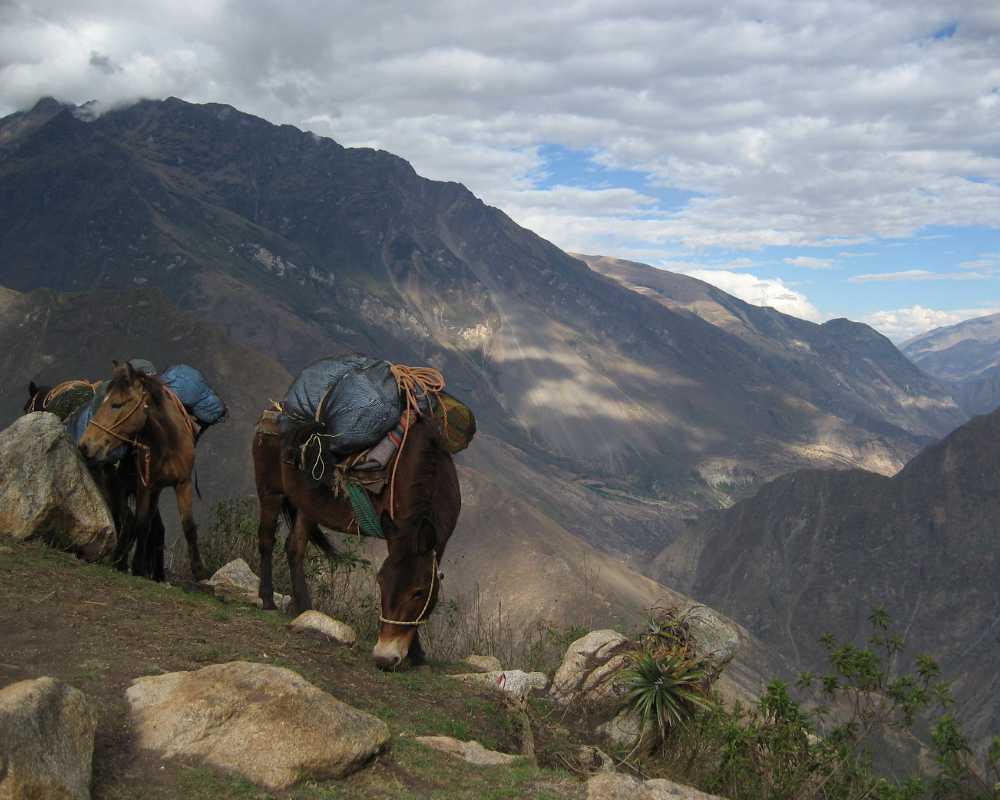
Choquequirao is a hidden gem within the Andes Mountains Peru, offering an off-the-beaten-path adventure to one of the most secluded Incan sites.
Known as the sister city of Machu Picchu, its remote location means it receives far fewer visitors, allowing for a more intimate exploration of its sprawling ruins and terraces.
Choquequirao is famous for its terraces that cling to the mountainside and its ceremonial centers, which are remarkably well-preserved. Unlike Machu Picchu, Choquequirao is still partly covered by the jungle, giving it an added sense of discovery and adventure.
Prepare for a multi-day trek that involves steep ascents and descents. Consider hiring a local guide or joining a trekking group not only for safety but also to gain insightful knowledge about the site’s history and significance.
6. Salkantay Trek
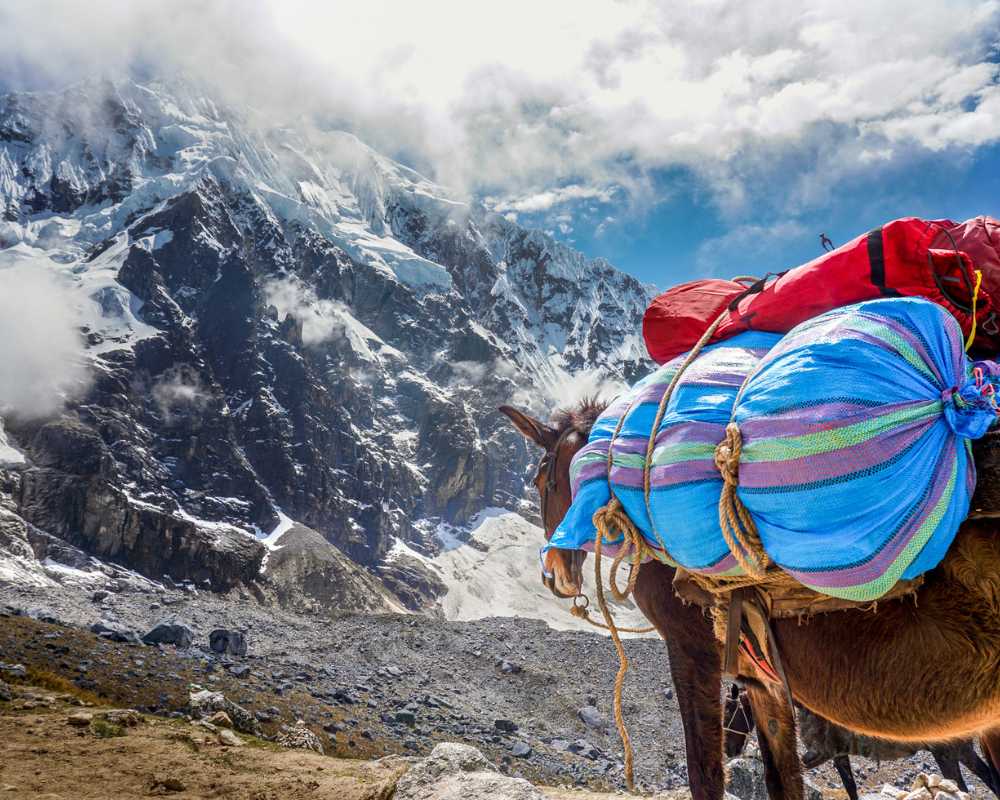
The Salkantay Trek is an alternative route to Machu Picchu that takes you through some of the most magnificent scenery in the Andes Mountains Peru.
This route is perfect for those seeking a less crowded path than the Inca Trail, offering diverse landscapes including snow-capped mountains, cloud forests, and ancient ruins.
The trek is named after Mount Salkantay, the sacred 20,574-foot mountain that provides stunning vistas and a spiritual backdrop to the journey.
The Salkantay Trek is famous for its breathtaking natural beauty and the opportunity to see Mount Salkantay up close, one of the highest and most revered peaks in the Andean range. It also offers a more varied trekking experience than the traditional Inca Trail.
Bring appropriate gear for various climates, as the trek passes through multiple ecosystems. Acclimatizing to the high altitude in Cusco for a few days before starting the trek is also crucial for a comfortable and enjoyable journey.
7. Huascarán National Park: highest peak in the Peruvian Andes

Huascarán National Park, nestled in the heart of the Andes Mountains Peru, is a paradise for trekkers, climbers, and nature lovers. The park is home to Huascarán, Peru’s highest mountain, and features stunning landscapes of glaciers, turquoise lakes, and diverse flora and fauna.
Its designation as a UNESCO World Heritage site underscores its global importance for natural preservation and the breathtaking beauty it offers.
The park is renowned for its high-altitude trekking routes and the Huascarán summit, which attracts mountaineers from around the world. Its diverse ecosystems are home to rare species such as the Andean condor and the spectacled bear.
When planning a visit, consider hiring local guides who not only enhance your safety but also enrich your experience with their knowledge of the park’s geography and biodiversity.
Ensure you have adequate travel insurance that covers high-altitude trekking and climbing activities.
8. The Uros Floating Islands
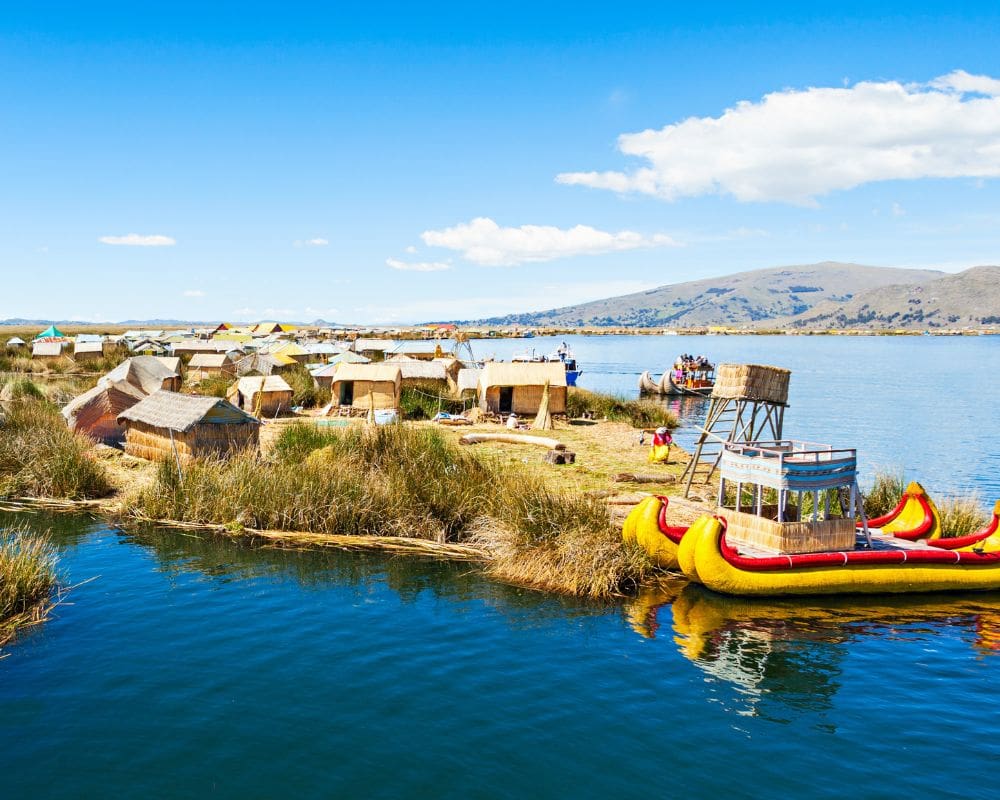
The Uros Floating Islands are a fascinating cultural highlight of Lake Titicaca in the Andes Mountains Peru.
Constructed entirely from totora reeds, these man-made islands are home to the Uros people, who have maintained their traditional way of life for centuries. Visiting the islands offers a unique glimpse into an ancient culture that has adapted to life on the water.
These islands are famous for their construction from the totora reeds that grow abundantly in the shallow parts of Lake Titicaca. The Uros people are known for their incredible ability to live sustainably, using the reeds for everything from building their homes to crafting boats.
Opt for a guided tour that includes a visit to several islands and offers the opportunity to learn directly from the Uros people about their customs and lifestyle. Be respectful of the inhabitants’ privacy and traditions, and always ask permission before taking photos.
9. Pisac Archaeological Park

The Pisac Archaeological Park is a must-visit site in the Andes Mountains Peru, showcasing a remarkable mix of Inca ruins and agricultural terraces. Situated in the Sacred Valley, the park offers stunning views of the valley below and insights into the advanced engineering skills of the Inca civilization.
The site includes a complex system of terraces, residential areas, and ceremonial centers, making it a fascinating destination for history and archaeology enthusiasts.
Pisac is famous for its well-preserved agricultural terraces, which demonstrate the Incas’ sophisticated farming techniques. The site also features an impressive sun temple and Intihuatana, an ancient astronomical observatory.
Visit Pisac in the early morning to avoid the crowds and to experience the ruins in the softer light of sunrise. Combine your visit with the Pisac market to explore local crafts and produce , making for a full day of cultural immersion.
10. Ollantaytambo Fortress
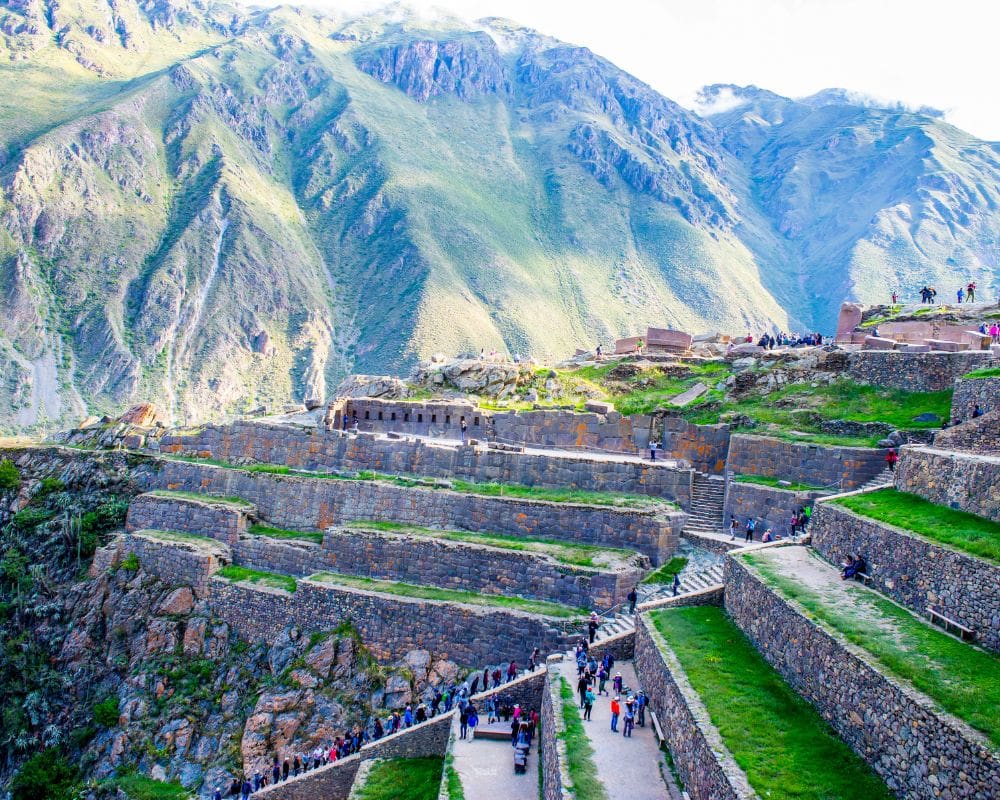
Ollantaytambo Fortress stands as a monumental testament to Incan architecture and strategic military planning in the Andes Mountains Peru. This ancient complex was both a temple and a fortress, strategically located to control the Sacred Valley.
Its impressive terraces and ruins offer insights into the Incan way of life and their architectural ingenuity, making it a fascinating stop for anyone traveling through the Sacred Valley.
Ollantaytambo is famous for its massive terraced walls, which were constructed to protect the valley from invaders. The site also serves as one of the few places where the Incas won a significant battle against the Spanish conquistadors.
=To fully appreciate the history and significance of Ollantaytambo, consider hiring a guide at the entrance of the site. Also, spend some time exploring the old town of Ollantaytambo, one of the few places where the original Incan urban planning is still intact.
11. Moray Terraces
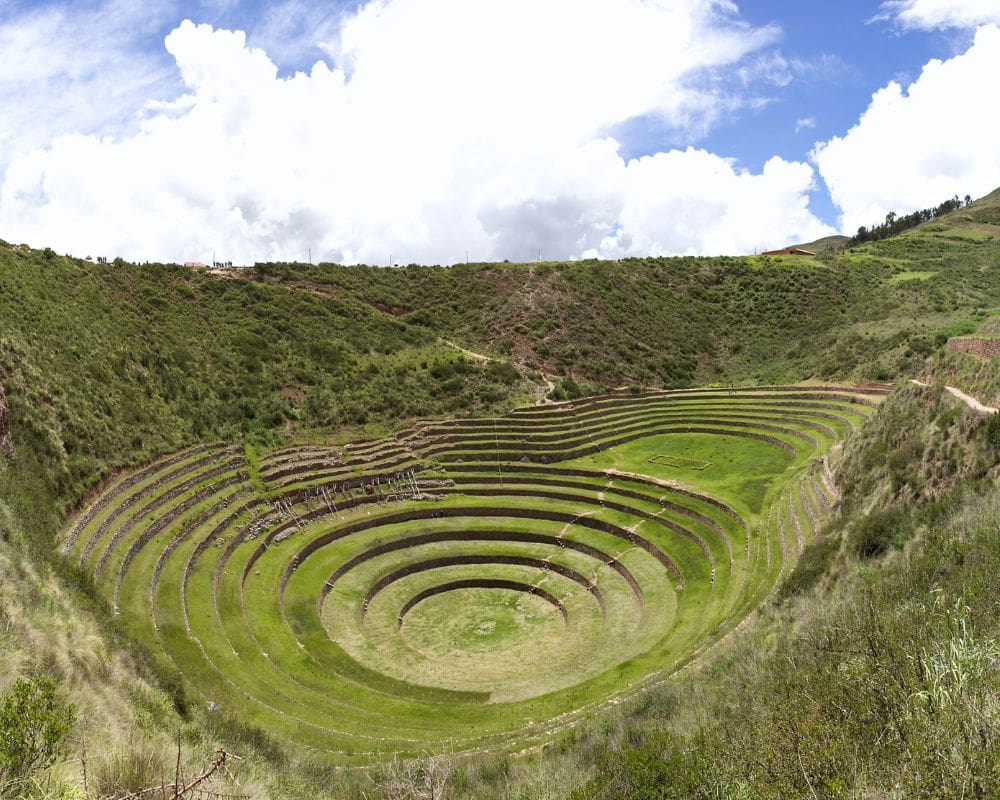
The Moray Terraces are an intriguing archaeological site in the Andes Mountains Peru, consisting of several terraced circular depressions. Believed to have been used by the Incas as an agricultural experimental station, these terraces created a series of microclimates to test crops at different altitudes.
The site’s design showcases the Incas’ advanced understanding of agriculture and ecology, making it a fascinating visit for those interested in ancient technologies.
Moray is famous for its unique circular terraces, which differ significantly from the straight terraced slopes commonly found throughout the Andes. It is believed that the Incas used the terraces to develop new crop varieties.
Visit Moray early in the morning or late in the afternoon to avoid the peak tourist times and to see the terraces in the best light. Wear comfortable walking shoes, as exploring the site involves a fair amount of walking on uneven surfaces.
12. Maras Salt Mines

The Maras Salt Mines, nestled in the Andes Mountains Peru, are an extraordinary sight, where thousands of salt pools cascade down the valley. These pre-Incan salt pans have been harvested by local communities for centuries and continue to produce pink salt today.
The sight of the shimmering pools against the rugged mountain backdrop is not only visually stunning but also offers a glimpse into traditional Andean livelihoods.
The mines are famous for their traditional salt extraction method, which has remained largely unchanged for hundreds of years. Maras salt is renowned for its unique flavor and high mineral content, making it a sought-after culinary ingredient.
Wear sunglasses and a hat, as the reflection from the salt pools can be quite intense. Consider purchasing some of the locally harvested salt from the on-site shop as a unique souvenir that supports the community.
13. Mismi Mountain
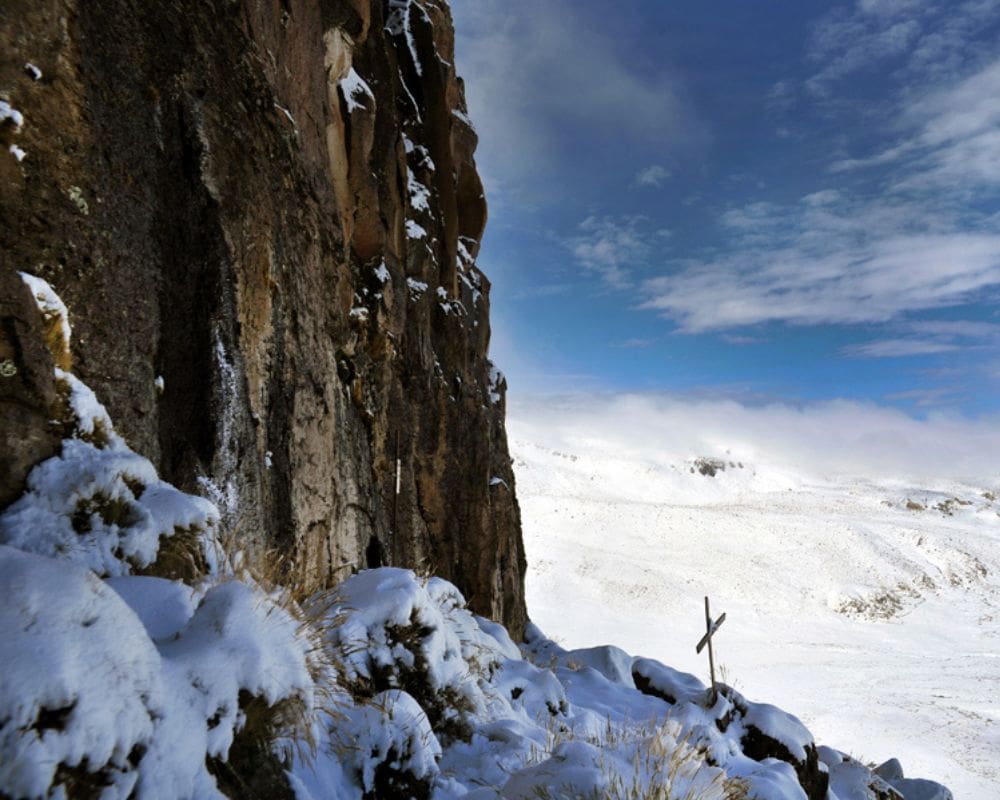
Nevado Mismi or Mismi Mountain, is a significant peak in the Andes Mountains Peru, credited as the source of the Amazon River, the world’s largest river by discharge volume of water.
The journey to Mismi offers trekkers unparalleled natural beauty, from snow-capped peaks to the birthplace of the mighty Amazon. This makes it an exceptional destination for those interested in geographic exploration and the natural wonders of the Andes.
Mismi Mountain is famous for being identified as the Amazon River’s most distant source in a 2001 scientific expedition. The area around Mismi provides stunning vistas of the Andes and a rare opportunity to stand at the very beginning of the Amazon.
The trek to Nevado Mismi is best undertaken with a local guide who knows the route and can provide insights into the area’s geography and significance. Ensure you’re well-acclimated to high altitudes before attempting the hike, as Mismi sits at over 5,000 meters above sea level.
14. Ausangate Mountain

Ausangate Mountain is revered as one of the most sacred mountains in the Andes Mountains Peru and is a part of the Vilcanota Mountain range. It offers one of the most challenging and rewarding trekking experiences in Peru, featuring stunning glacial lakes, thermal hot springs, and vibrant alpine ecosystems.
The Ausangate Trek is a spiritual journey for many, providing breathtaking natural beauty and a deep sense of connection to Pachamama, or Mother Earth.
Ausangate is famous for its dramatic landscapes, including colorful sedimentary mountains, and is a key part of local Andean cosmology. The mountain and its surrounding areas are known for their spectacular beauty and the annual Qoyllur Rit’i festival, which attracts thousands of pilgrims.
Due to the high altitude and challenging nature of the trek, it is essential to be well-acclimatized and in good physical condition.
15. Huayna Picchu

Huayna Picchu, the iconic peak that towers over Machu Picchu in the Andes Mountains Peru, offers a challenging yet rewarding hike for those looking to add an adventurous twist to their Machu Picchu visit.
The steep and narrow paths lead to breathtaking views of the ancient Incan city below, making it a popular addition to the Machu Picchu experience. Climbing Huayna Picchu not only offers a unique perspective of the ruins but also an exhilarating sense of accomplishment.
Huayna Picchu is famous for its dramatic location and the unique bird’s-eye view it provides of Machu Picchu. It also houses the Temple of the Moon, one of the few significant structures built at such a high elevation by the Incas.
Tickets to Huayna Picchu are limited and must be booked well in advance, often several months before your visit. Start the climb early to enjoy cooler temperatures and less crowded paths, and be prepared for a physically demanding trek.
16. Cordillera Blanca
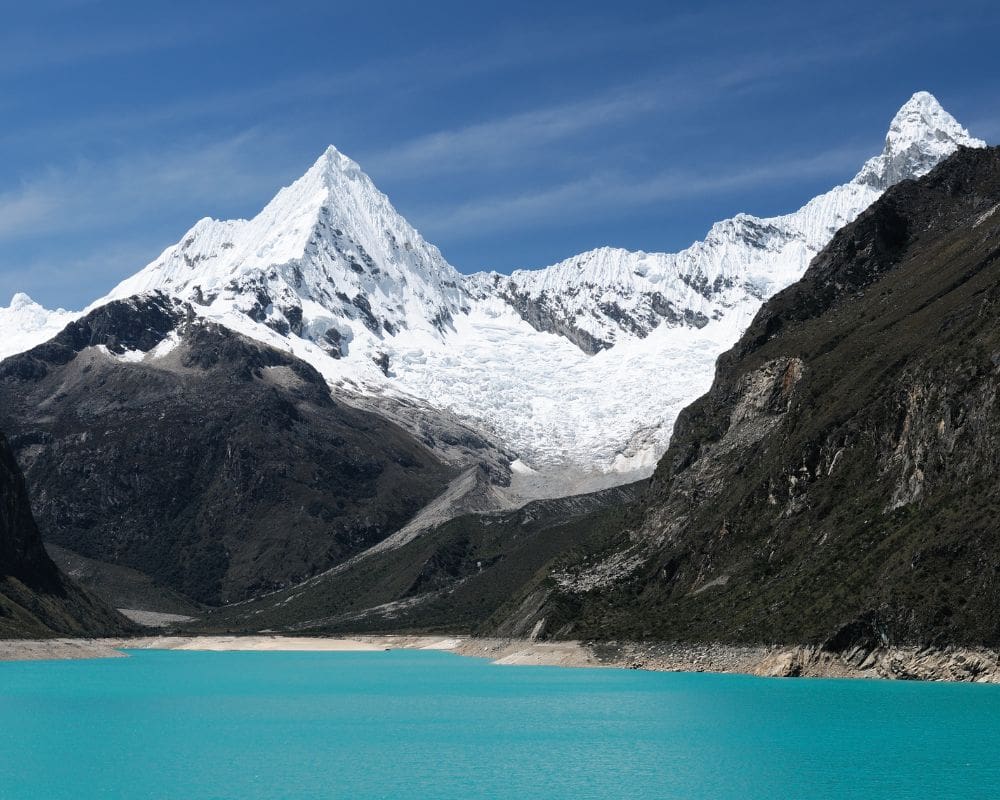
The Cordillera Blanca in the Andes Mountains Peru is a paradise for mountaineers and trekkers, boasting the highest tropical mountain range in the world.
This breathtaking region offers a plethora of outdoor activities, from challenging climbs to scenic day hikes, all surrounded by stunning glaciers, crystal-clear lakes, and diverse flora and fauna.
The Cordillera Blanca is renowned for housing Huascarán, the highest mountain in Peru, and the beautiful Laguna 69, a turquoise lake set against a backdrop of snow-capped peaks. It’s also a hotspot for mountaineering due to its numerous peaks over 6,000 meters.
Acclimatize properly to avoid altitude sickness by spending a few days in Huaraz, the gateway to the Cordillera Blanca, before attempting any high-altitude treks or climbs. Hiring a local guide can enhance your experience and ensure safety.
17. Cordillera Huayhuash
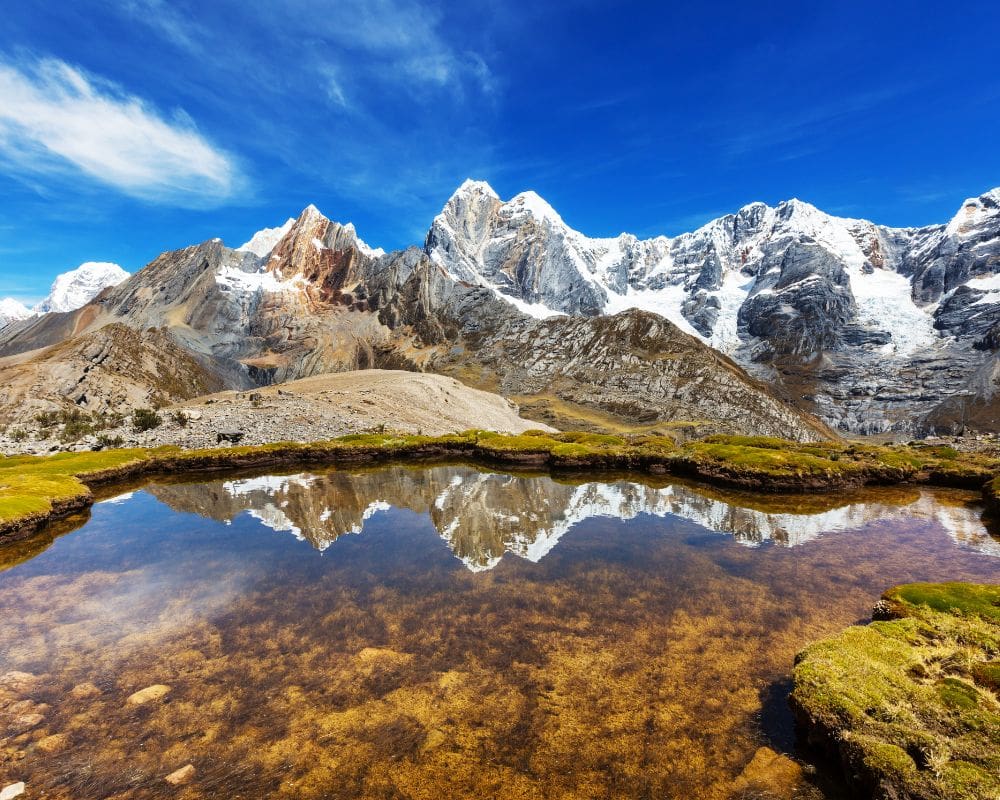
The Cordillera Huayhuash, a compact yet stunningly beautiful mountain range in the Andes Mountains Peru, offers one of the most spectacular trekking circuits in the world.
Known for its sharp, jagged peaks, pristine glacial lakes, and remote trails, the Cordillera Huayhuash trek is a challenging but immensely rewarding experience for avid trekkers and nature lovers.
The Cordillera Huayhuash is famous for its rugged terrain, including Yerupajá, the second-highest mountain in Peru, and Siula Grande, made famous by the book and film “Touching the Void”.
The circuit is renowned for its breathtaking landscapes and challenging trekking conditions. Be sure to train for the trek, as the high altitude and physical demands require good fitness.
Due to the remote nature of the Cordillera Huayhuash, it’s highly recommended to join a guided trek with a reputable company that includes porters, cooks, and emergency equipment.
17. Chavín de Huántar
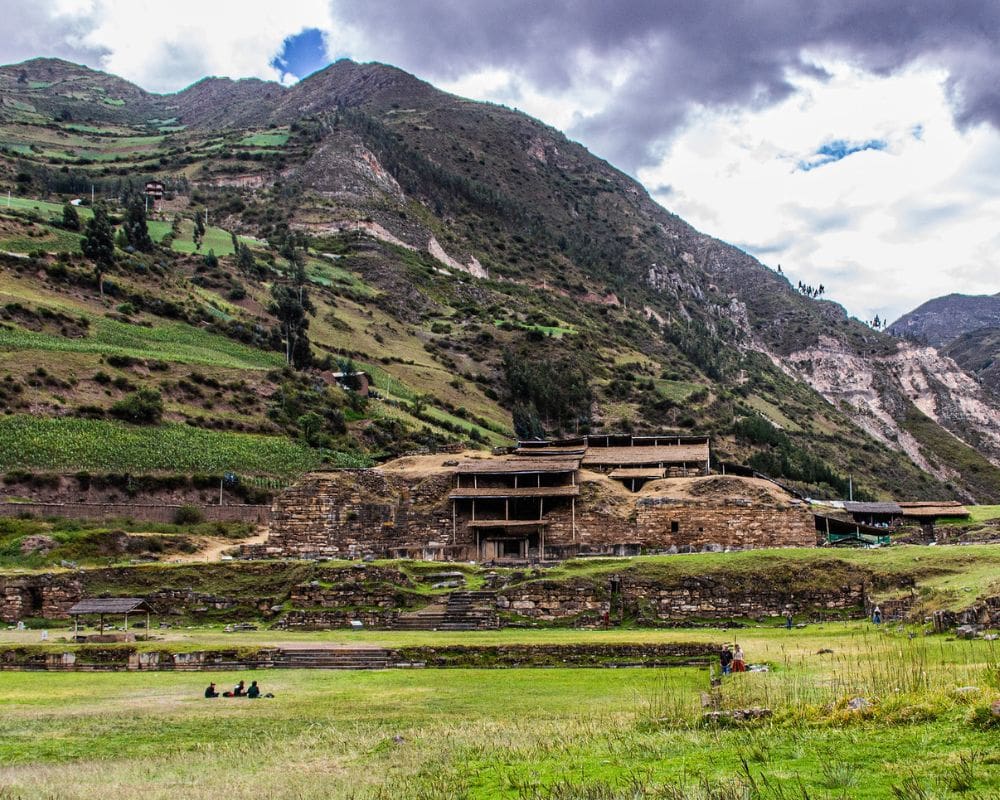
Chavín de Huántar, a pre-Columbian archaeological site in the Andes Mountains Peru, offers a fascinating glimpse into the Chavín culture, one of the earliest and most influential civilizations in ancient Peru.
The complex features a series of underground passages, ceremonial rooms, and striking stone sculptures, including the famous Lanzón monolith. Visiting Chavín de Huántar provides a unique opportunity to explore the roots of Andean culture and its sophisticated symbolic and religious world.
Chavín de Huántar is famous for its intricate stone carvings and labyrinthine network of underground passages and chambers. It served as a religious and cultural center that influenced much of the Andes region.
To fully appreciate the historical and cultural significance of Chavín de Huántar, consider hiring a local guide who can provide detailed explanations of the site’s history and artifacts.
Wear comfortable shoes and bring a flashlight to explore the dimly lit interior tunnels more comfortably.
18. Laguna 69
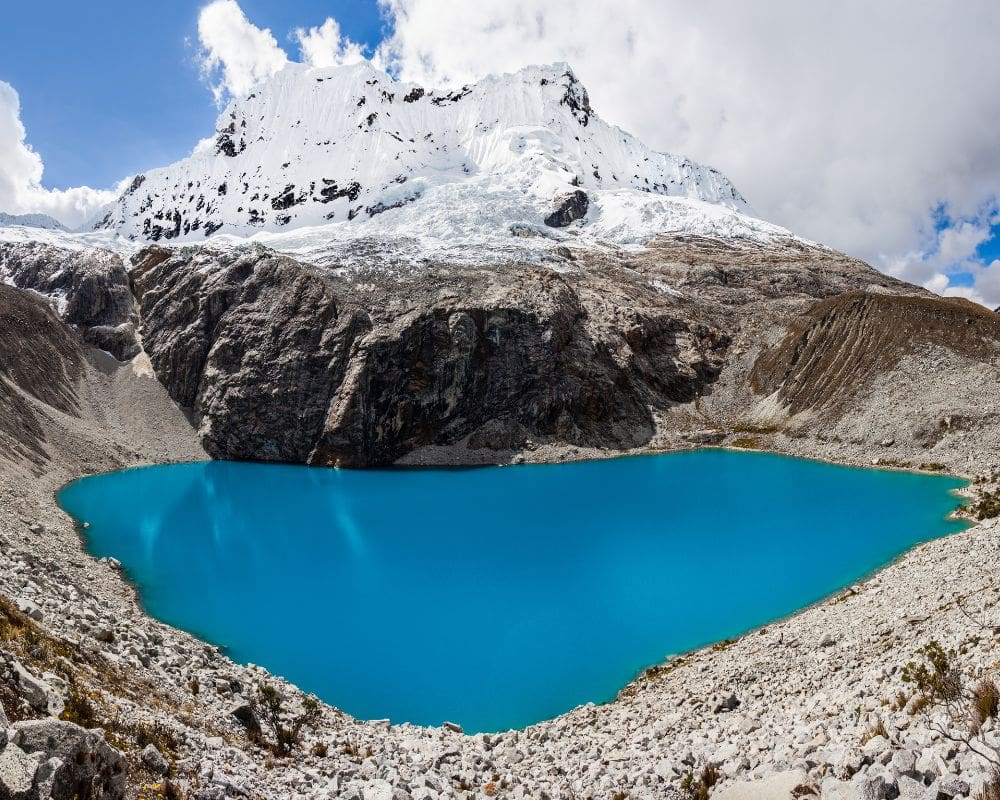
Laguna 69, nestled in the heart of the Cordillera Blanca in the Andes Mountains Peru, is a stunning turquoise lake that has become a must-visit for trekkers in the region.
The hike to Laguna 69 is a rewarding challenge, offering breathtaking views of snow-capped peaks, waterfalls, and colorful Andean flora along the way. The lake’s vibrant blue waters set against the backdrop of towering mountains create a serene and picturesque landscape.
Laguna 69 is famous for its striking turquoise waters and its location at the base of Chacraraju Mountain. It has gained popularity as one of the most beautiful day hikes in the Cordillera Blanca.
Start the hike early to ensure enough time to enjoy the lake and return before dusk. The trail can be steep and rocky in places, so wearing sturdy hiking boots and bringing walking poles can help make the journey more comfortable.
19. Santa Cruz Trek

The Santa Cruz Trek in the Cordillera Blanca of the Andes Mountains Peru is one of the most popular trekking routes in Peru, known for its incredible scenic beauty, accessible trails, and the opportunity to witness the diverse landscapes of the Andes.
This 4-day trek traverses through lush valleys, high-altitude passes, and past stunning alpine lakes, offering panoramic views of some of the highest peaks in the Cordillera Blanca.
The trek is famous for the Punta Unión pass, which offers spectacular views of the surrounding mountains, including Taulliraju. It’s also known for its accessibility to trekkers of moderate fitness levels, making it a popular choice for experiencing the Andes.
Pack layers for the trek, as temperatures can vary significantly from the valleys to the high passes. Consider hiring a donkey or porter service available in the region to carry your gear, allowing you to enjoy the hike with less weight.
20. Kuélap Fortress
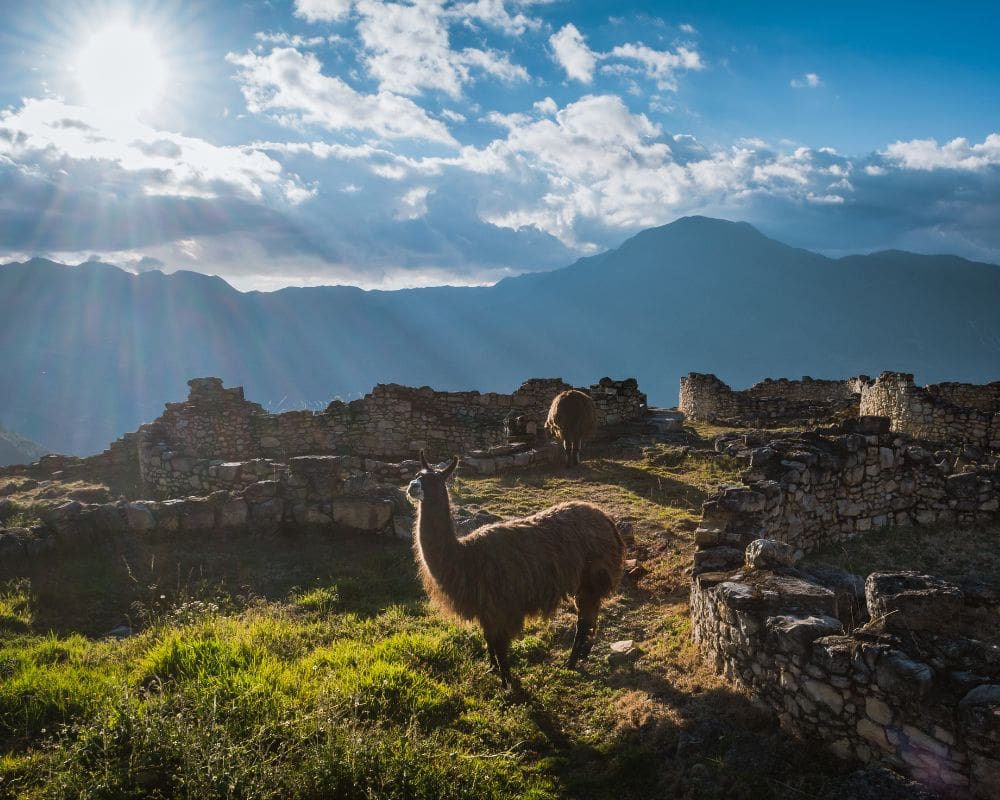
Kuélap Fortress, often referred to as the “Machu Picchu of the north,” is a remarkable archaeological site located in the Andes Mountains Peru.
This ancient walled city was built by the Chachapoyas, also known as the “Warriors of the Clouds,” and stands as a testament to their architectural ingenuity and strategic military knowledge.
The site offers visitors the chance to explore hundreds of circular stone houses, massive defensive walls, and intricate reliefs amid cloud forest-covered mountains.
Kuélap is famous for its massive exterior walls, which reach up to 20 meters in height, and its unique location on a ridge overlooking the Utcubamba Valley. It predates the Incan empire, offering insights into a less-known pre-Columbian culture.
Accessing Kuélap has become easier with the introduction of a cable car system that offers stunning views of the surrounding landscape. Plan to visit during the dry season (May to September) for the best weather and visibility, and consider combining your visit with a trip to the nearby Gocta Falls for a full day of exploration.
21. Gocta Waterfall
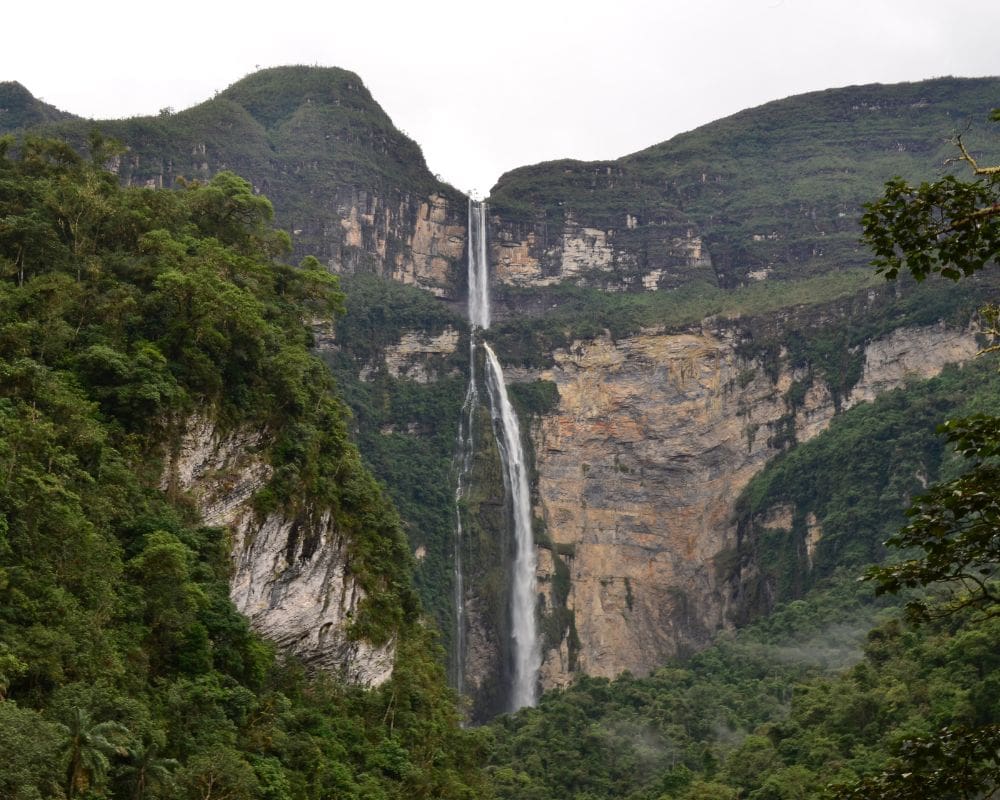
Gocta Waterfall, hidden within the lush landscapes of the Andes Mountains Peru, stands as one of the tallest waterfalls in the world. Its discovery for the wider world in the early 21st century has made it a must-visit destination for nature lovers and adventure seekers.
The trek to Gocta offers a captivating journey through dense Amazonian cloud forests, where the air is filled with the sound of cascading water and the calls of exotic birds.
Gocta Waterfall is famous for its impressive height, with estimates placing it as the third or sixteenth tallest in the world, depending on the measurement criteria used. It is also known for the myths and legends surrounding it, including tales of a golden-haired mermaid.
Wear sturdy waterproof hiking boots for the trek, as the path can be slippery and muddy, especially after rain. Hiring a local guide not only supports the community but also enriches your experience with stories about the waterfall’s history and local lore.
22. Llactapata Ruins
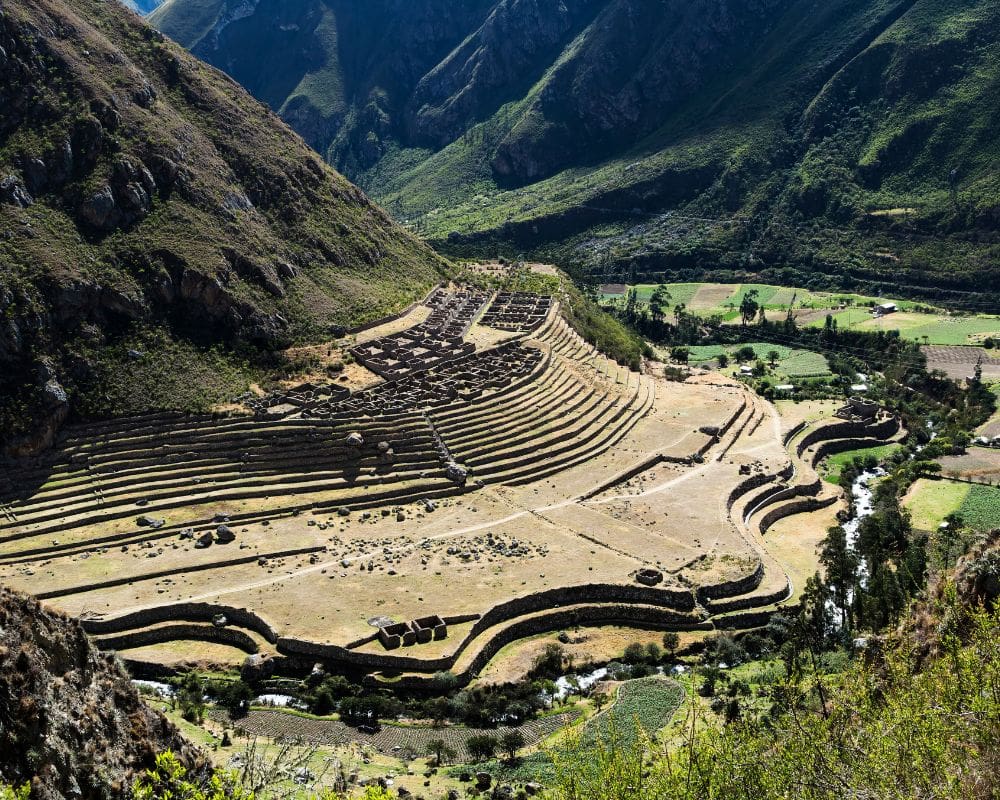
The Llactapata Ruins, located in a stunning, remote section of the Andes Mountains Peru, offer a fascinating glimpse into Incan architecture and their strategic placement of settlements.
Overlooking the Urubamba Valley, Llactapata serves as a lesser-known but equally captivating counterpart to the nearby Machu Picchu, providing insight into the Incan network of trails and sites.
The journey to Llactapata is itself a rewarding experience, offering panoramic views and a sense of solitude that is hard to find at more crowded sites.
Llactapata is famous for its direct line of sight to Machu Picchu, suggesting a strategic and ceremonial connection between the two sites. It is also known for its sun temple, which aligns with the sun during the solstices.
Include a visit to Llactapata as part of a multi-day trek to Machu Picchu, such as the Salkantay Trek, to fully appreciate its historical context and enjoy the surrounding natural beauty.
23. Lares Trek

The Lares Trek offers an authentic Andean experience through the heart of the Andes Mountains Peru, winding through traditional Quechua villages, stunning mountain passes, and therapeutic hot springs.
Unlike the more famous Inca Trail, the Lares Trek allows for cultural immersion, allowing trekkers to meet local weavers and farmers, and learn about their way of life.
The Lares Trek is famous for its cultural interactions, including visits to local communities that maintain traditional weaving techniques. It is also known for the breathtaking scenery of the Lares Valley, with its high-altitude lakes and snow-capped peaks.
Pack warm clothing and a good sleeping bag, as nights can be cold in the high altitudes. Consider bringing small gifts or purchasing crafts directly from the local communities as a way to support them and enrich your cultural experience.
24. Cruz del Condor
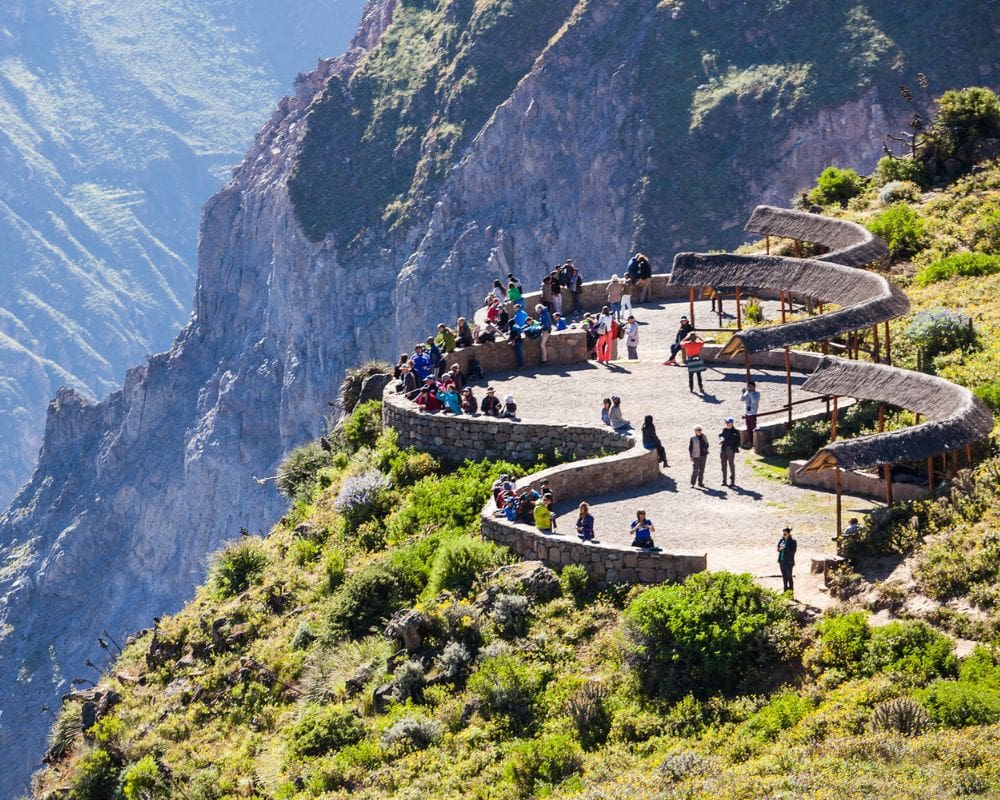
Cruz del Condor is an iconic viewpoint in the Andes Mountains Peru, offering one of the best opportunities to witness the majestic flight of the Andean condors.
Situated along the Colca Canyon, one of the deepest canyons in the world, this spot attracts visitors early in the morning, when condors are most likely to soar on the thermal currents rising from the canyon’s depths.
Cruz del Condor is famous for its close-up views of Andean condors, the largest flying birds in the world by combined measurement of weight and wingspan. The site also offers stunning vistas of the Colca Canyon.
Arrive early in the morning (around sunrise) for the best chance to see the condors in action and to avoid the crowds that gather later in the day. Bring binoculars and a camera with a good zoom lens to capture detailed images of the condors and the breathtaking scenery.
25. Qoyllur Rit’i festival site
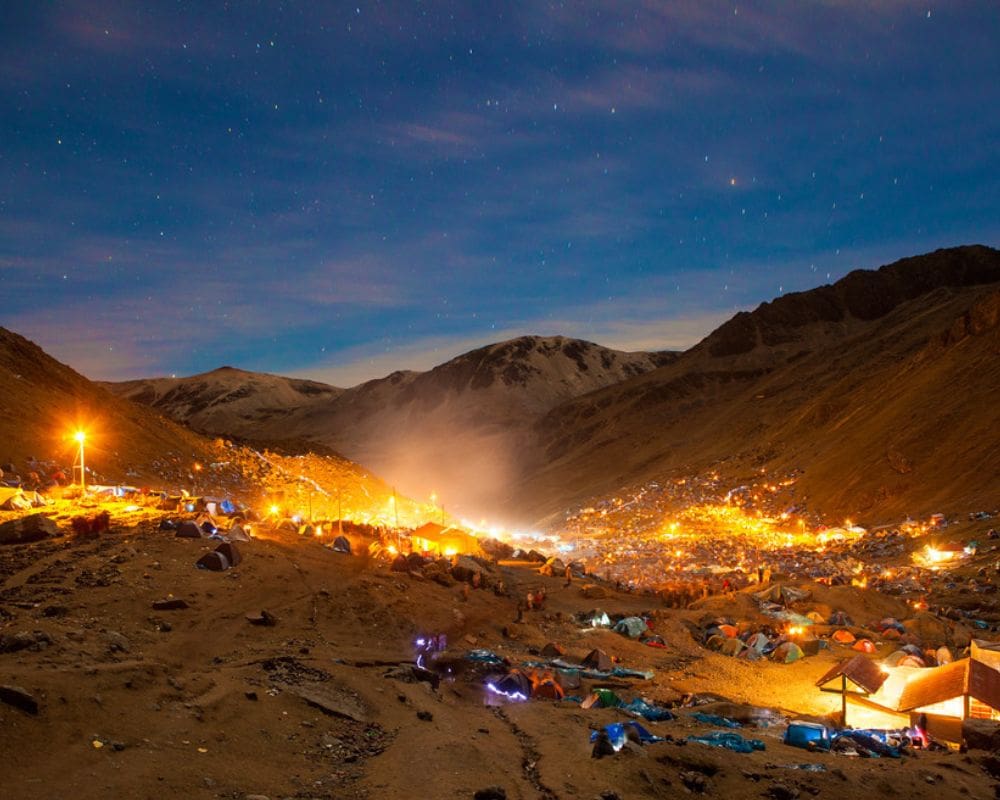
The Qoyllur Rit’i festival site, located high in the Andes Mountains Peru, near the Sinakara Mountain, is the setting for one of the most important indigenous religious events in the Americas.
This annual pilgrimage, blending pre-Columbian and Catholic traditions, draws thousands of participants to celebrate the appearance of Christ on the mountain and to honor the mountain spirits (Apus).
Qoyllur Rit’i is famous for its spiritual significance and the pilgrimage that involves challenging treks at high altitudes, often in cold temperatures. It is also known for the Ukukus, ritual guardians who play a central role in the festival’s ceremonies.
If you plan to attend the Qoyllur Rit’i festival, prepare for high altitude and cold weather by acclimatizing in Cusco or another high-altitude location beforehand. Respect the spiritual and cultural significance of the festival by participating as an observer and following local customs and guidance.
26. Inca Trail

The Inca Trail is one of the most iconic treks in the Andes Mountains Peru, leading hikers through breathtaking landscapes to the ancient city of Machu Picchu.
This challenging route covers diverse terrains, from cloud forests to mountain passes, and features numerous archaeological sites along the way, offering a unique combination of natural beauty and historical intrigue.
Completing the Inca Trail is a rewarding experience, culminating in the unforgettable first view of Machu Picchu at sunrise from the Sun Gate.
The Inca Trail is renowned for its historical significance, being part of the extensive network of paths built by the Incas. It is also famous for its stunning landscapes and the variety of flora and fauna encountered along the way.
Book your Inca Trail permit well in advance, as they are limited and sell out quickly, especially for the peak trekking months.
27. Nevado Alpamayo
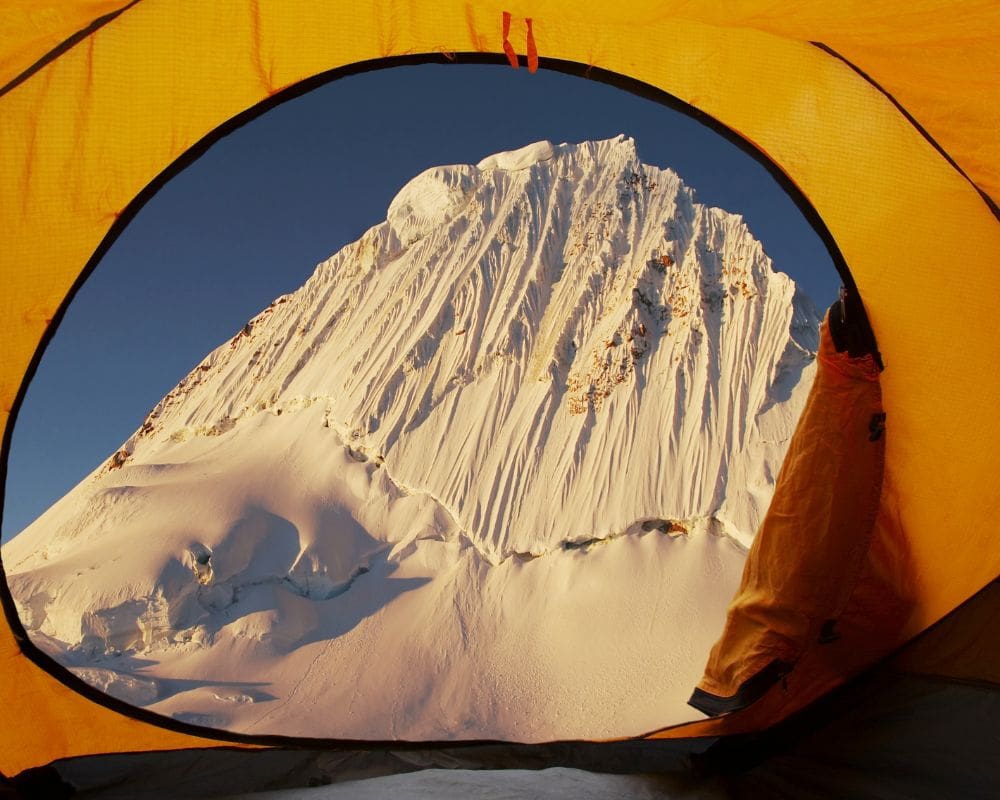
Nevado Alpamayo, often referred to as the most beautiful mountain in the world, is a breathtaking peak in the Andes Mountains Peru. Its perfect pyramid shape and sheer, fluted ice faces make it a favorite subject for photographers and a coveted destination for experienced climbers.
Nevado Alpamayo is famous for its aesthetic beauty, characterized by its almost symmetrical pyramid shape and its striking ice flutes. It has been voted the “Most Beautiful Mountain in the World” in various surveys among mountaineers.
Due to the technical difficulty of climbing Alpamayo, it’s essential to have prior ice climbing experience and be well-acclimatized to high altitudes. Joining an expedition with a reputable company that provides experienced guides and safety equipment is crucial for a successful ascent.
28. Palccoyo Rainbow Mountain

Palccoyo Rainbow Mountain offers a less crowded alternative to Vinicunca, showcasing the stunning colors of the Andes Mountains Peru with a more accessible trek.
This site features not just one but three colorful mountains, along with ancient stone forests and traditional Quechua communities, making it a comprehensive cultural and natural experience.
The easier hike and fewer crowds make Palccoyo an excellent option for those seeking the beauty of Peru’s rainbow mountains without the strenuous climb.
Palccoyo is famous for its series of three rainbow-colored mountains, offering a more serene and less trodden path to witness these geological wonders. It’s also known for its panoramic views and the nearby stone forest, which adds to its unique landscape.
Wear comfortable walking shoes and bring layers, as the weather can change rapidly. Because Palccoyo is at a high altitude, spend a few days acclimatizing in Cusco or the Sacred Valley before your visit to prevent altitude sickness.
29. Pastoruri Glacier
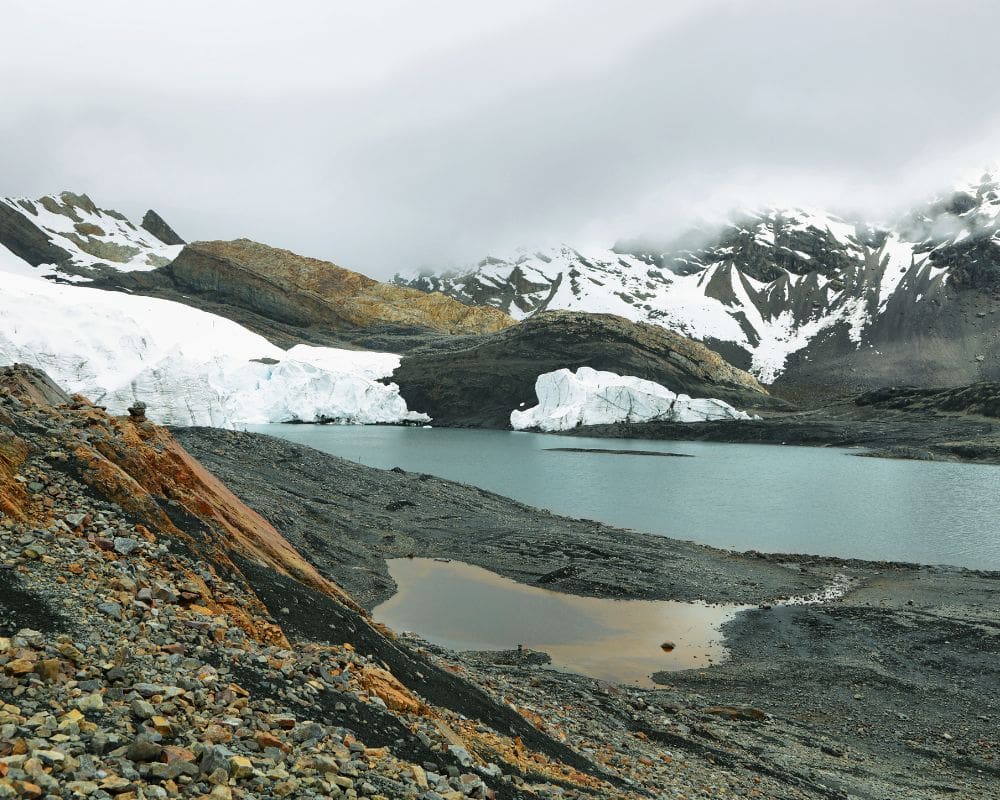
The Pastoruri Glacier, situated in the Andes Mountains Peru, is a striking remnant of the tropical glaciers, offering visitors a unique opportunity to see ice formations near the equator.
This glacier is part of Huascarán National Park and has become a focal point for observing the effects of climate change, as it has significantly receded over the years.
Despite its retreat, Pastoruri remains a popular destination for those interested in glaciology, adventure sports like ice climbing, and the breathtaking high-altitude landscapes of the Cordillera Blanca.
Pastoruri Glacier is renowned for being one of the few accessible glaciers in tropical South America, offering a glimpse into the natural beauty and environmental changes affecting our planet. It is also a popular spot for ice climbing and snow sports.
Since the glacier is at a very high altitude, it’s crucial to acclimatize properly before your visit to avoid altitude sickness. Environmental sustainability is a key concern, so follow all guidelines to minimize your impact.
30. Raqchi Ruins
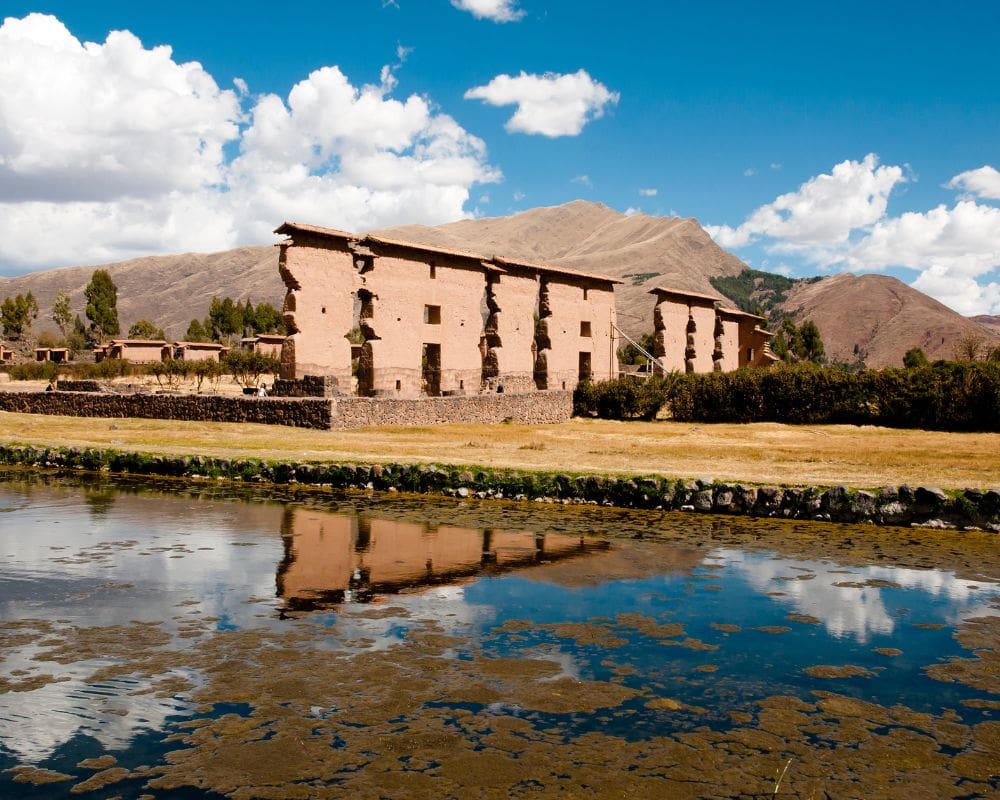
The Raqchi Ruins in the Andes Mountains Peru, are an impressive archaeological site featuring the ancient Temple of Wiracocha, one of the most significant Inca deities.
This site offers a unique glimpse into Incan architecture and society, with its expansive compound that includes residential areas, storage structures, and a sophisticated irrigation system.
Raqchi’s historical significance and the scenic beauty of its surroundings make it a fascinating stop for those interested in the breadth of Incan culture and engineering.
Raqchi is famous for the Temple of Wiracocha, an enormous structure believed to be one of the largest roofed buildings constructed by the Incas.
The site also showcases an impressive array of Incan terraces and qolqas (storage silos), highlighting the advanced agricultural and logistical capabilities of the empire.
31. Sillustani Burial Towers
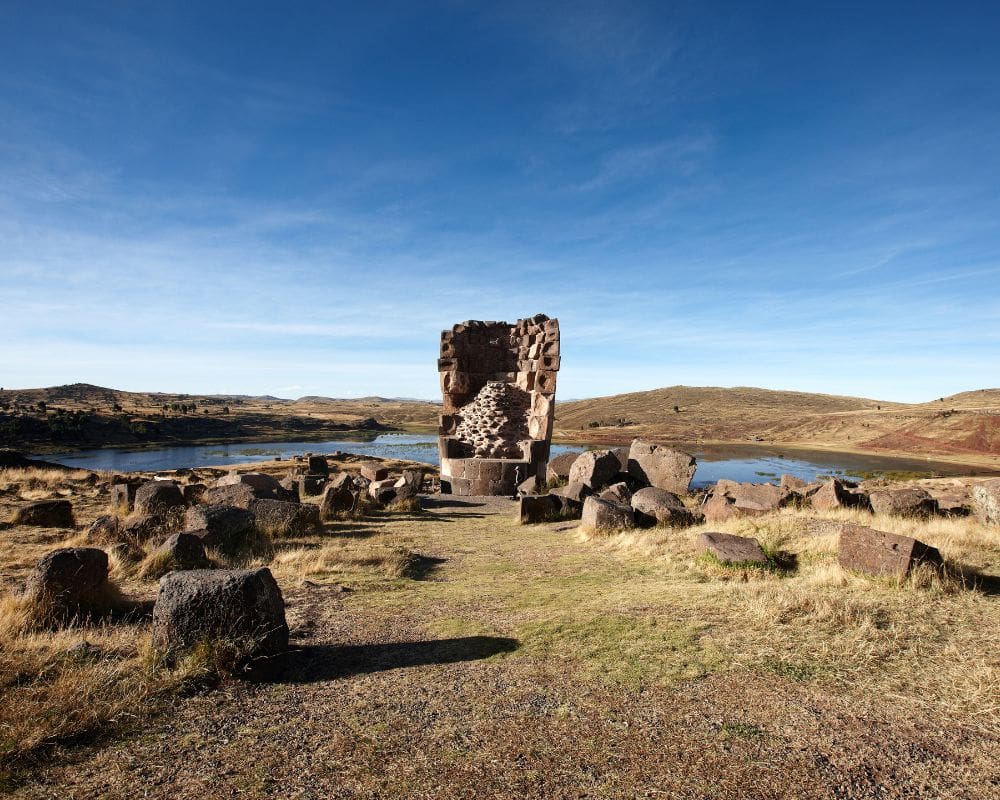
Sillustani Burial Towers, located near Puno in the Andes Mountains Peru, are a striking pre-Incan and Incan archaeological site known for its chullpas, or funerary towers.
Overlooking the Umayo Lagoon, these cylindrical towers offer a glimpse into the burial practices and beliefs of the Qulla people and their successors, the Incas.
Sillustani is famous for its well-preserved chullpas, some of which stand over 12 meters tall. These towers are unique in their construction and significance, serving as a testament to the region’s pre-Columbian funeral rites.
Visit in the late afternoon for softer light and fewer crowds, making for a more reflective experience and better photography. Dress warmly, as the site can be quite windy and cool due to its elevation and proximity to the lagoon.
32. Apurimac River Canyon
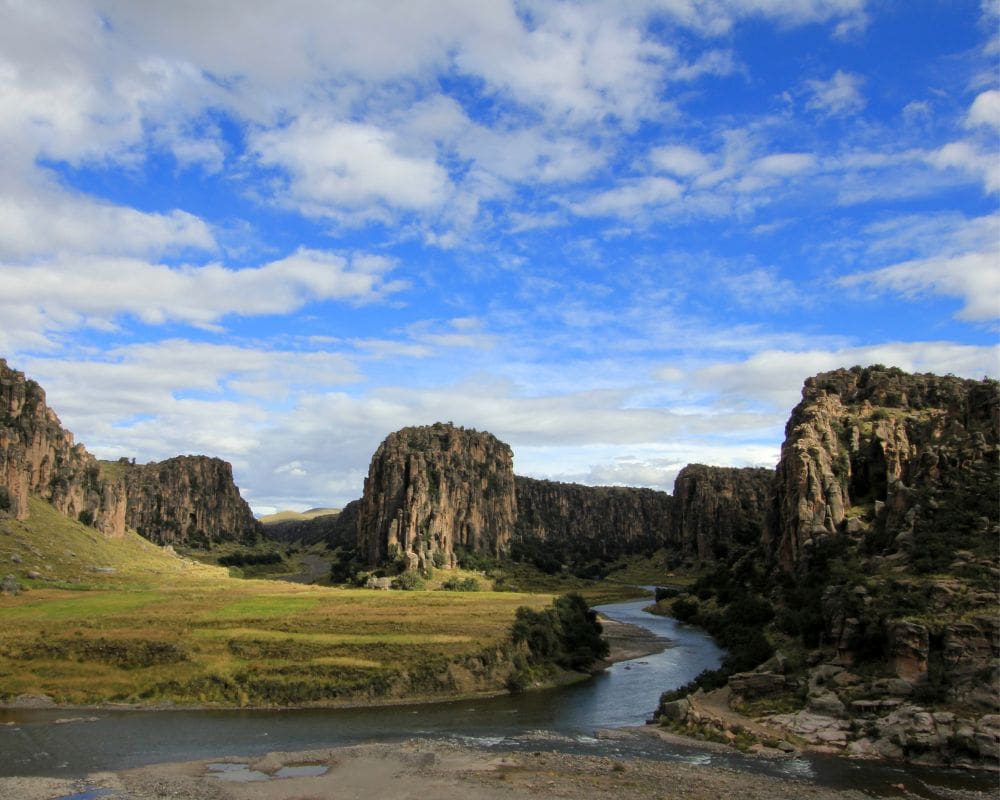
The Apurimac River Canyon, cutting deeply through the Andes Mountains Peru, is a breathtaking natural wonder known for its dramatic scenery and as a premier destination for white-water rafting.
The canyon offers one of the deepest gorges in the world, providing not only thrilling adventure sports but also serene spots for camping and bird watching, including sightings of the majestic Andean condor.
The canyon is renowned for its world-class white-water rafting, offering some of the most challenging and exhilarating rapids in South America. It is also recognized for its dramatic depth, rivaling that of the Grand Canyon.
Ensure you’re well-prepared for white-water rafting by choosing a reputable tour operator with experienced guides. For those not into rafting, hiking along the canyon offers equally stunning views and a peaceful way to appreciate its grandeur.
33. Caral-Supe Archaeological Site
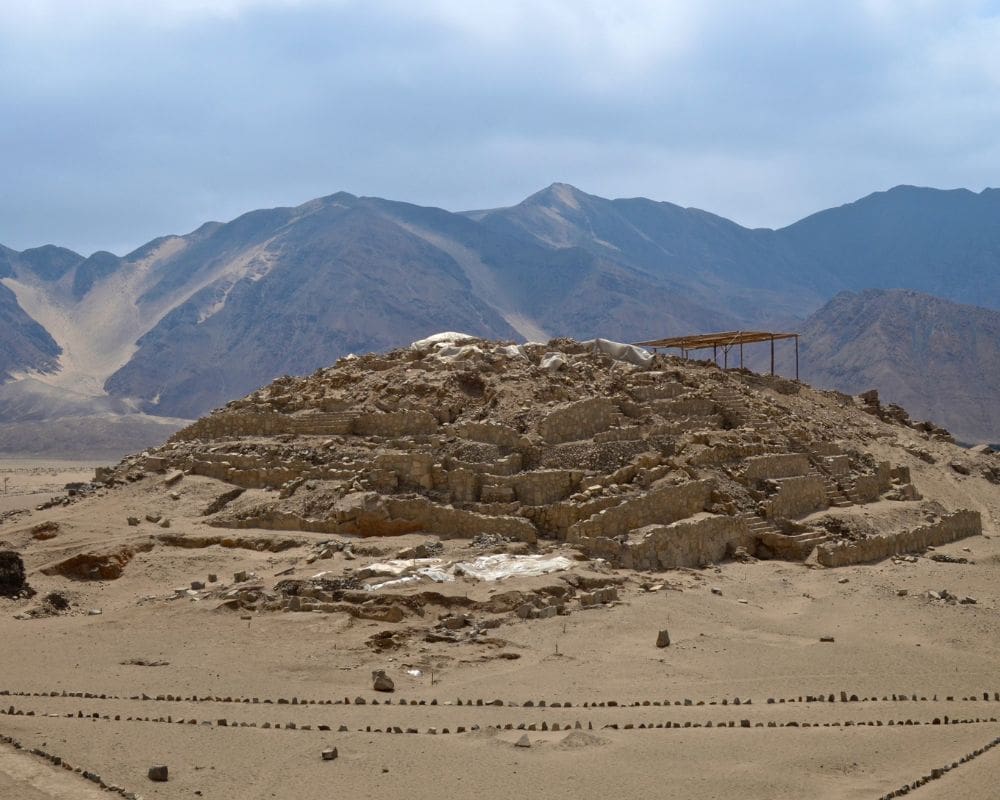
The Caral-Supe Archaeological Site in the Andes Mountains Peru is one of the oldest urban centers in the Americas, dating back over 5,000 years. This ancient city offers insights into the Norte Chico civilization, highlighting sophisticated architectural designs, including pyramids, plazas, and residential areas.
Caral’s significance lies in its contribution to our understanding of early urban planning and social organization in the pre-Columbian Americas.
Caral is famous for being the most ancient city in the Americas and a UNESCO World Heritage Site. Its well-preserved layout and structures provide evidence of a complex society with knowledge of astronomy, music, and agriculture.
Wear comfortable walking shoes and bring sunscreen and a hat, as the site is expansive and exposed to the sun. Guided tours are highly recommended to fully appreciate the history and significance of the ruins.
34. Vilcabamba, The Last Refuge of the Incas
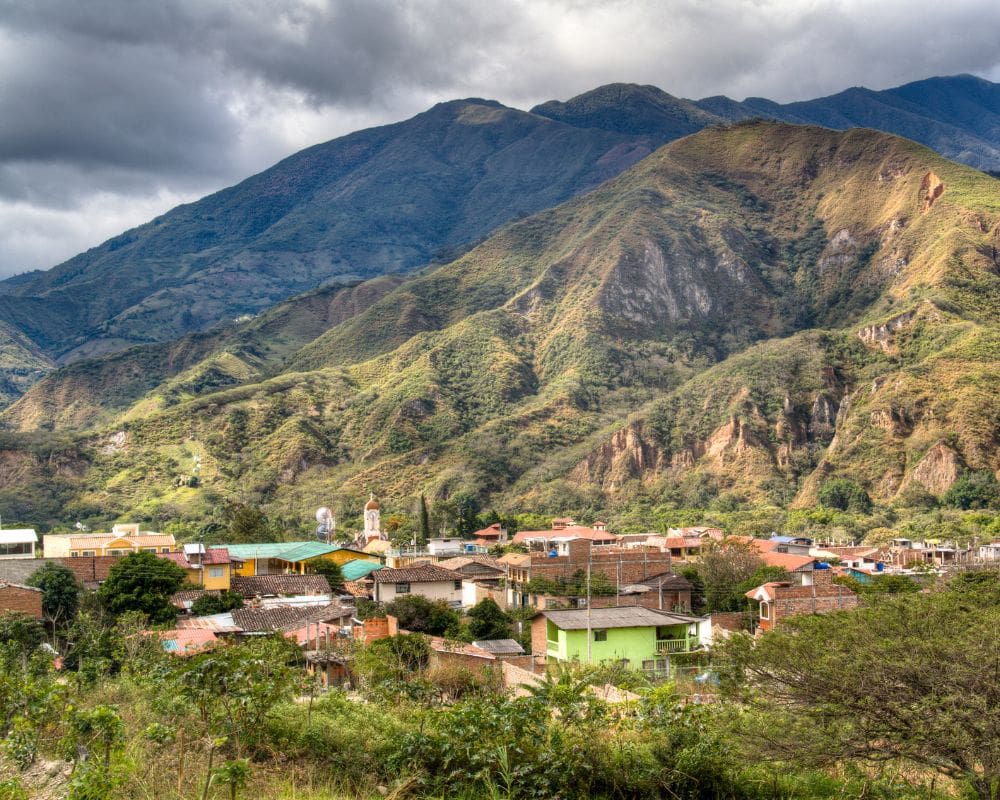
Vilcabamba, known as the “Last Refuge of the Incas,” holds a special place in the history of the Andes Mountains Peru as the final stronghold of the Incan resistance against Spanish conquest.
This remote area, with its rugged terrain and lush forests, provided a natural fortress for the last Incan emperor and his followers. Today, it offers a mix of archaeological sites and natural beauty for those looking to explore a less-visited part of Inca history.
Vilcabamba is famous for its historical significance as the site of the last Incan capital before the empire’s fall. It is also known for the challenging treks that lead to its ruins, offering adventurers a combination of historical exploration and natural beauty.
Be prepared for a physically demanding journey to reach Vilcabamba, involving trekking through dense vegetation and varied terrain. Hiring a local guide is crucial not only for navigation but also for gaining insights into the area’s rich history and culture.
35. Salcantay Mountain

Salcantay Mountain, towering majestically in the Andes Mountains Peru, is revered by trekkers and mountaineers for its imposing presence and the challenging routes it offers.
Part of the Vilcabamba Range, Salcantay provides a breathtaking backdrop for the alternative trek to Machu Picchu, offering stunning natural landscapes, including glaciers, cloud forests, and alpine meadows.
Salcantay Mountain is famous for its striking beauty and as an alternative route to Machu Picchu, offering a less crowded but equally stunning trekking experience. The mountain is also considered sacred, holding significant cultural importance in Incan mythology.
Ensure you are well-acclimatized to the altitude before attempting the trek, as Salcantay reaches elevations over 6,000 meters (19,685 feet).
36. Paron Lagoon
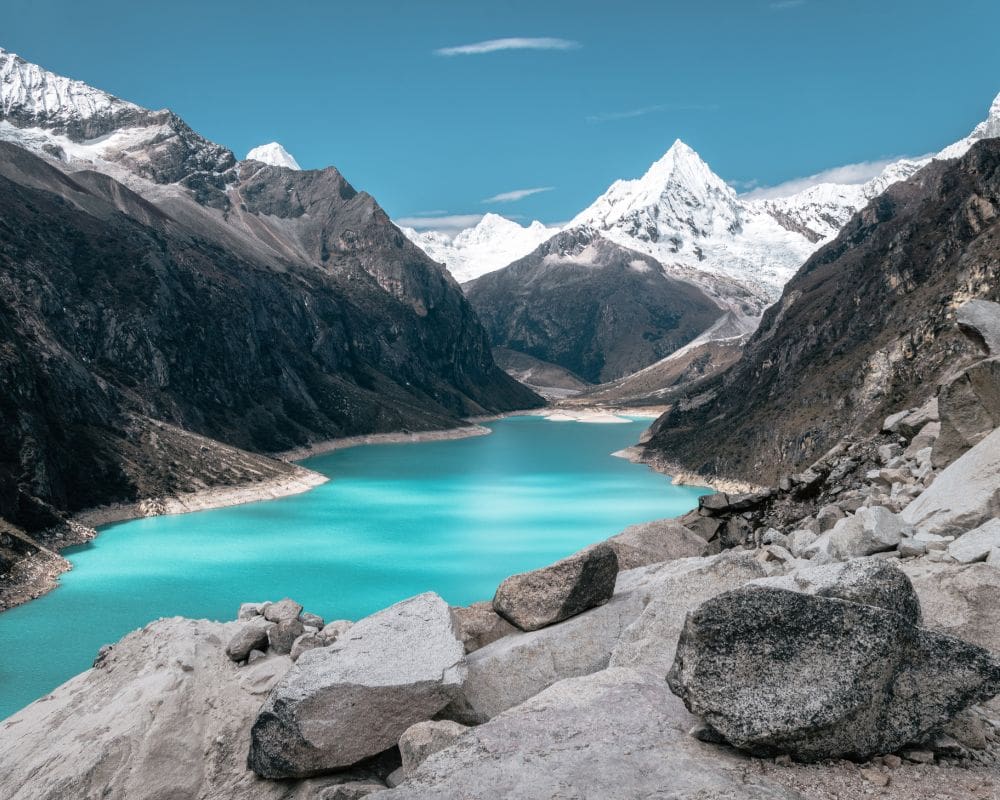
Paron Lagoon (Laguna Parón), nestled in the heart of the Cordillera Blanca in the Andes Mountains Peru, is a dazzling body of water known for its vivid turquoise color and the spectacular mountain scenery that surrounds it.
As the largest lagoon in the Cordillera Blanca, Parón offers a tranquil setting for kayaking, photography, and hiking, with views of towering peaks such as Artesonraju, often associated with the Paramount Pictures logo.
Parón Lagoon is renowned for its breathtaking natural beauty, including its crystal-clear waters and the surrounding snow-capped mountains. It’s also a popular spot for kayaking and photography, offering serene and picturesque landscapes.
The best time to visit Parón Lagoon is during the dry season, from May to September, when the weather is clearer and the views are most spectacular.
37. Huacachina Oasis

Huacachina Oasis, a true desert gem in the Andes Mountains Peru, offers a picturesque escape with its palm-fringed lake surrounded by towering sand dunes.
This small village provides a unique adventure in the Ica region, from sandboarding and dune buggy rides to relaxing by the oasis.
Huacachina is famous for being one of the few natural oases in South America, providing a striking contrast to the surrounding desert landscape. It’s also known for its adventure sports, particularly sandboarding and dune buggy tours.
Take a dune buggy tour in the late afternoon to enjoy the exhilaration of racing up and down the dunes and witness a spectacular sunset over the desert.
38. Callalli Stone Forest
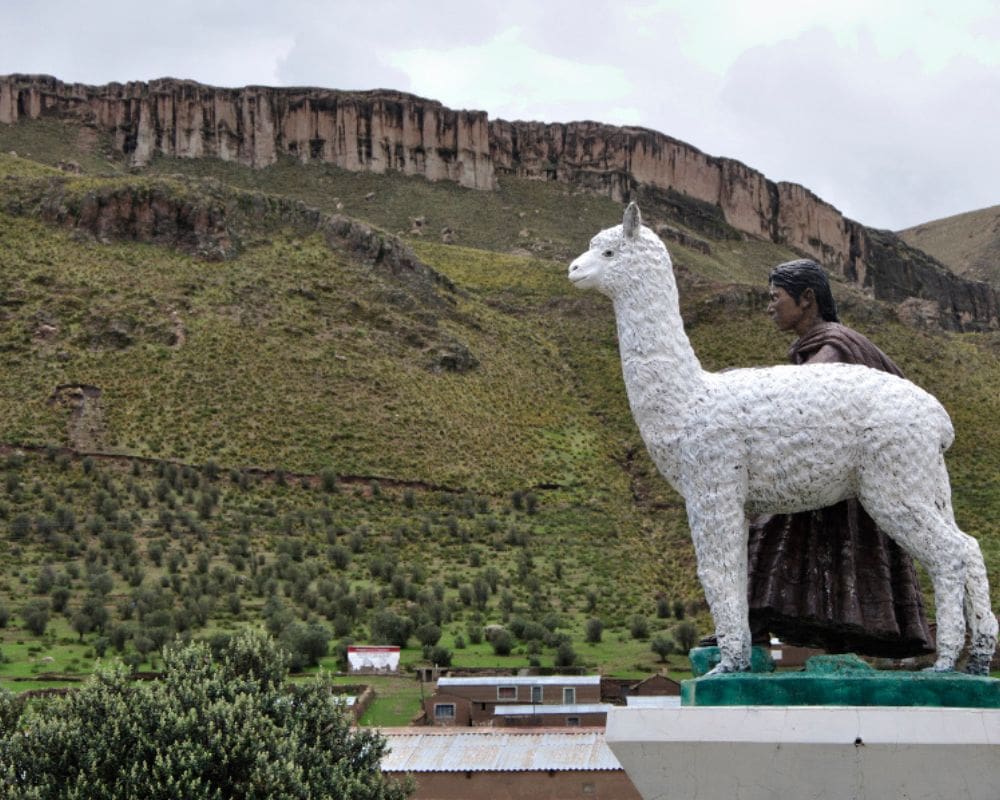
Callalli Stone Forest, situated in the remote highlands of the Andes Mountains Peru, is an awe-inspiring natural wonder characterized by its towering volcanic rock formations.
This lesser-known destination offers a landscape that seems otherworldly, with its massive stone columns and boulders shaped by centuries of wind and water erosion.
Callalli Stone Forest is renowned for its dramatic rock formations, which create a labyrinth of natural towers and spires. It’s also celebrated for its scenic beauty and the opportunity it offers for hiking and photography in a tranquil, unspoiled environment.
Due to its remote location, it’s advisable to visit Callalli Stone Forest with a local guide or tour operator who knows the area well. Wear sturdy hiking boots and bring layers, as temperatures can vary widely in this high-altitude desert landscape.

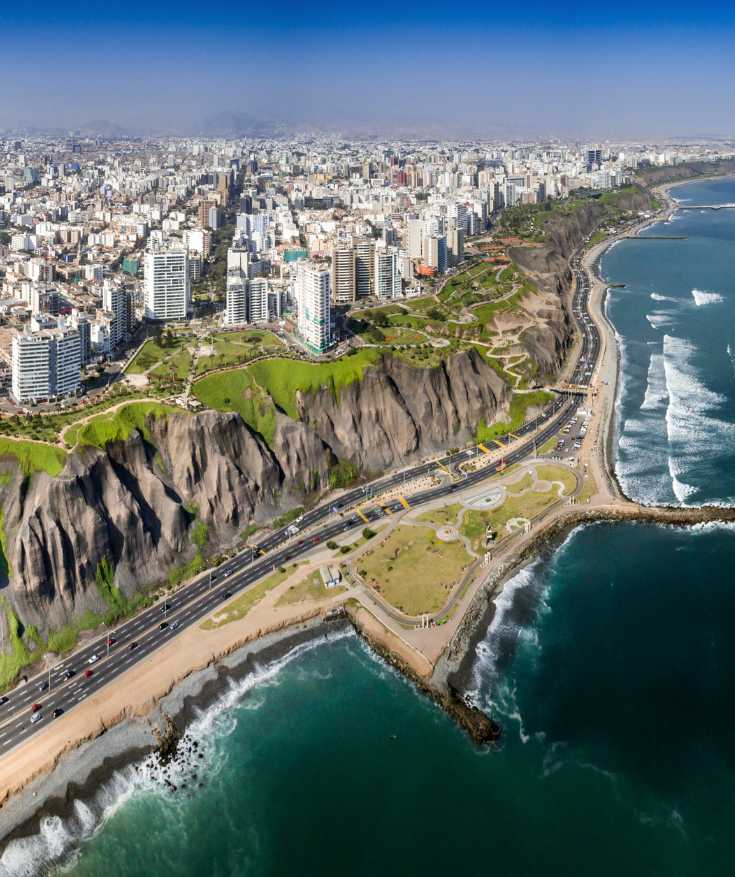
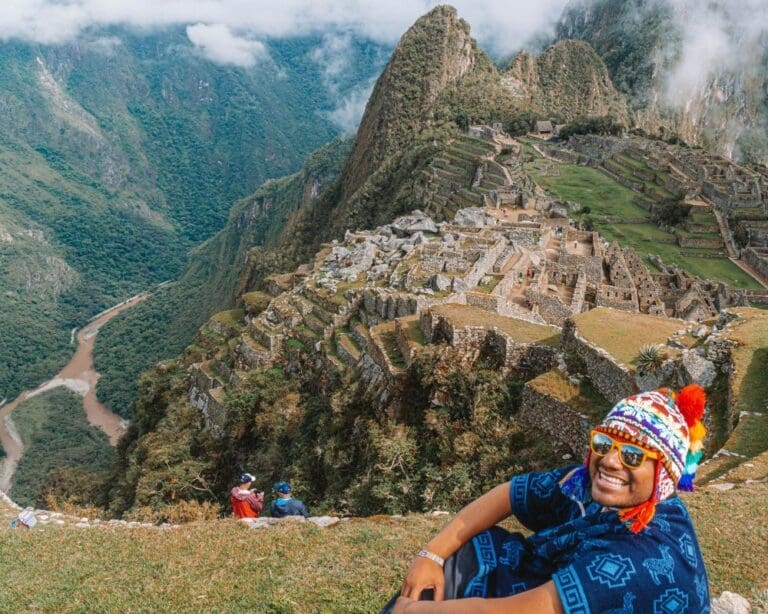
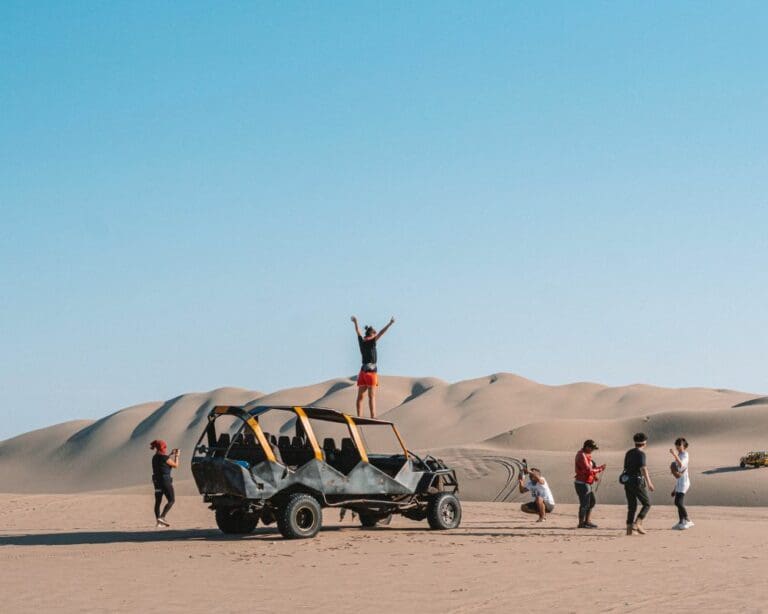

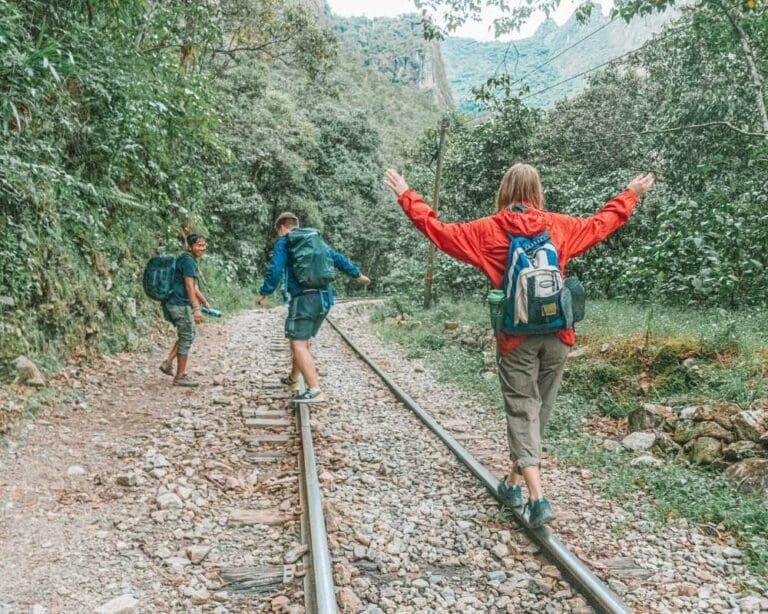
![The 24 Peru Regions, explained [with free map!]](https://b3076322.smushcdn.com/3076322/wp-content/uploads/Peru-Regions-Map-768x614.jpg?lossy=2&strip=1&webp=1)